
© 2017 The Association for Water and Rural Development
RESILIM-O:
Resilience in the Limpopo Basin
Program– Olifants
MILESTONE 3: Progress Report No 2
Under the
Lower Olifants catchment
Agricultural Support Initiative
(AgriSI)
05/10/2018

MILESTONE 3: PROGRESS REPORT NO 2
| 2
Acknowledgements
The USAID: RESILIM-O project is funded by the U.S. Agency for International Development under
USAID/Southern Africa RESILIENCE IN THE LIMPOPO BASIN PROGRAM (RESILIM). The RESILIM-O project is
implemented by the Association for Water and Rural Development (AWARD), in collaborationwith partners.
Cooperative Agreement nr AID-674-A-13-00008.
© Association for Water and Rural Development (AWARD)
P O Box 1919
Hoedspruit 1380
Limpopo, South Africa
T 015-7930503
W award.org.za
Company Reg. No. 98/03011/08
Non-profit org. Reg. No. 006 –821

MILESTONE 3: PROGRESS REPORT NO 2
| 3
ABOUT USAID: RESILIM
USAID’s Resilience in the Limpopo River Basin (RESILIM) program addresses ongoing degradation in the river
Basin in southern Africa, where people face water shortages, increased floods, and declines in crop
productivity as climate change further stresses an already water limited region.
There are two components to the program; one operating at a basin-scale (RESILIM-B, which isimplemented
by USA-based Chemonics and addresses similar issues at the scale of the four SADC member states thatshare
the Limpopo Basin (South Africa, Botswana, Zimbabwe and Mozambique) and a catchment-scale project
(RESILIM-O)that It is being implemented by the Association for Water and Rural Development (AWARD).
Both projects share the same overall objectives. You can find out more information on the RESILIM projects
on www.usaid.gov website and www.award.org.za.
The USAID’s RESILIM-O focusses on the Olifants catchment. The program aims to reduce the vulnerability of
people and ecosystems inthe Olifants Catchment specifically, by improving how transboundary natural
resources are managed. By understanding the systemic causes of vulnerability, including climate
vulnerability, it is promoting new ways of thinking and acting to promote integrated water and biodiversity
management.
ABOUT AWARD
At AWARD, we recognize that the natural world’s resources are limited, and undergoing rapid depletion and
transformation. We know current practices of use and management are inadequate to deal with the changes
and challenges we are facing. We design practical interventions to address the vulnerability of people and
ecosystems, and merge considerations fromboth environmental and social perspectives. Our approach
involves thinking across disciplines, boundaries and systems.
We are working with diverse people and institutions in the water and biodiversity sectors in the Olifants
River Catchment to understand the multiple vulnerabilities tochange, including climate change. Along with
quality scientific contributions, our engagement in the socio-political context of the Olifants River
Catchment allows us begin to begin to institutionalize integrated, resilience-based practices, providing a
foundation for robust development policy and practice in the in this river catchment, and beyond
1
.
The Olifants Catchment: An overview
The Olifants River Catchment falls within the Limpopo River Basin, which is part of an international drainage
basin that stretches across South Africa, Mozambique, Zimbabwe and Botswana. In fact, the Olifants River
contributes nearly 40% of the waterthat flowsin the Limpopo River making it an important catchment in
the system as a whole
2
.
1
AWARD: Annual Report.2016/2017 Financial Year. RESILIENCE IN THE LIMPOPO – OLIFANTS.10/31/2017
2
As above

MILESTONE 3: PROGRESS REPORT NO 2
| 4
AWARD, 2017.
At the heart of this catchment is the Olifants River, a vital artery that flows for 560 kilometres through
South Africa and into Mozambique, where it is known as the Rio dos Elefantes in Mozambique.
This mighty river originates in South Africa’s Mpumalanga Highveld, flowing northwards before curving in an
easterly direction through the Kruger National Park and into Mozambique, finally finding rest in the salty
water of the Indian Ocean near Xai Xai, just north of Maputo.
The main tributaries of theOlifants River are the Wilge, Elands, Ga-Selati, Klein Olifants, Steelpoort, Blyde,
Klaserie and Timbavati Rivers.
Along with its tributaries, it is one of the six major Lowveld river systems, occupying an area just short of
55 000 square kilometres. It traverses three provinces in South Africa; Gauteng, Mpumalanga and Limpopo.
About 3.5 million people live on the South African side of the catchment. In Mozambique, it flows through
Gaza Province, which is home to about 700 000 people.
A system under change
Our catchment is the foundation of our livelihoods and development. Yet the river and associated natural
resources in the Olifants Catchment are under threat.
Unchecked pollution, inappropriate land resource use, weak and poorly enforced policies and regulations
and poor protection of habitats and biodiversity are degrading the Olifants at an alarming rate. What’s more,
the area is however under threat from factorssuch as mining for heavy metals, inappropriate land
management, rural sprawland unsustainable useof natural resources. This affects the levelof goods and
services provided by the ecosystem.
The diverse population groups living in the Olifants Catchment all have one thing in common; they rely on
the river and the catchment’s natural biodiversity for their livelihoods. This reliance can be direct or indirect.
Rural communities rely on it for things such as traditional medicine,grazing and browse, fuel, food and
housing materials. Somepeople in river-side communities harvest reeds, collect water from the river for

MILESTONE 3: PROGRESS REPORT NO 2
| 5
washing and drinking and use it for recreational and spiritual practices. Subsistence farmers in Mozambique
rely heavily on the catchment’s flood plains. There are also large mines and associated industries, large
scale agriculture and the wildlife economy, which all rely on a healthy, functioning river system. Often
people forget that what they do upstream affects people down stream, sometimes with dire consequences.
The catchment isour home and it is worth investing in its future. The work reported here is part of the
ongoing activities of the RESILIM- O project under the grant from USAID: Southern Africa.

MILESTONE 3: PROGRESS REPORT NO 2
| 6
Project partners
Mahlatini Development Foundation (MDF) isa small public benefit non-profit organization consisting of rural
development practitioners whospecialize in participatory learning and action processes, sustainable natural
resource management and low externalinput farming systems, including a focus on rain water harvesting,
conservation agriculture, intensive homestead food production, food security, climate change adaptation
micro finance and enterprise development.
MDF designs and implements rural developmentprogrammesand training processes providing learning
processes for adults all the way from semi- literatefarmers topost graduate university level. We work in
partnership with government and non-government organisations alike. We are sensitiveto and mainstream
where possible gender, disability and people living with HIV/AIDs

MILESTONE 3: PROGRESS REPORT NO 2
| 7
Contents
Table of Contents
1 Executive Summary.........................................................................................................8
1.1 Progress for the reporting period...................................................................................8
2 Project Objectives..........................................................................................................8
2.1 Overview of RESILIM-O Project objectives.........................................................................8
2.2 Sub-grant Project Objectives........................................................................................8
3 Milestone Description .......................................................................................................9
3.1 Definition of milestone and purpose................................................................................9
4 Approach/ Process/ Activities..........................................................................................10
4.1 Summary of activities...............................................................................................10
5 Progress and Results......................................................................................................11
5.1 Learning and mentoring.............................................................................................11
5.1.1 Botshabelo– Mid season reviewand planning ................................................14
5.1.2 Tunnel construction ..............................................................................16
5.1.3 Innovations and Experimentation ..............................................................17
5.1.4 Networking & collaboration .....................................................................30
5.2 Success and Challenges in meeting milestone.................................................................. 35
5.3 Monitoring and evaluation..........................................................................................35
5.3.1 Garden monitoring (July-September 2018) ...................................................35
5.3.2 Indicators: Assessment October 2018 ..........................................................42
5.3.3 Project Life Change Questions: ................................................................. 43
5.3.4 Work Plan for next period (10 October- 15 December 2018). ..............................44
6 Overall Progress of Project..............................................................................................45
6.1 Integration of milestone status....................................................................................45
6.2 Project risk and mitigation summary.............................................................................46
6.2.1 Implementation risks and mitigation ..........................................................46
6.2.2 Financial risks and mitigation ...................................................................46
6.3 Project work not directly linked to the milestone.............................................................46
6.3.1 Quantitative measurements .....................................................................46

MILESTONE 3: PROGRESS REPORT NO 2
| 8
1Executive Summary
1.1Progress for the reporting period
Continuation from reporting for Inception period of Phase II (Milestone 2):
•Training workshops for 1 village (Fenale) in seed saving and crop calendars, 4 villages for herb
production and quality control (Sedawa, Botshabelo, Mametja Turkey)
•Tunnel construction in 6 villages (Fenale, Lepelle, Mametja, Sedawa, Botshabelo, Turkey)
•Local marketing initiative for organic herbs and vegetables
•Continuation with water issues exploration workshops in 2 villages (Lepelle, Sedawa), to continue
discussions and planning and do community screening of videos
•Garden monitoring; Sedawa, Turkey, Botshableo, Mametja, Lorraine.
•Seasonal review workshop- Botshabelo learning group
•Research study for water productivity and water use to augment implementation
IMPLEMENTATION TEAM
MAHLATHINI: Erna Kruger, Sylvester Selala, Betty Maimela (intern)
AWARD: Cryton Zazu, Bigboy Mkhabela,
2Project Objectives
2.1Overview of RESILIM-O Project objectives
RESILIM-O is large multi-faceted, multi-stakeholder, cross-boundary programme to reduce vulnerability to
climate change through building improved transboundary water and biodiversity governance and
management of the Olifants Basin through the adoption of science-based strategies that enhance the
resilience of its people and ecosystems through systemic and social learning approaches. The programme
has been running for four years and is being implemented by AWARD (The Association for Water and Rural
Development) with funding from USAID.
The Agricultural Support Initiative (AgriSI) was initiated as a sub-grant process within the larger
programmed towards the end of 2016. This initiative works specifically with climate change adaptation
processes with smallholder communities in both the middle and lower Olifants River basin. In the lower
Olifants it is being implemented jointly by Mahlathini Development Foundation and AWARD.
The Agricultural Support Initiative (AgriSI) addresses two of the RESILIM-O programme objectives directly:
i.To institutionalize systemic, collaborative planning and action for resilience of ecosystems and
associated livelihoods through enhancing the capacity of stakeholders to sustainably manage natural
resources of the Olifants River Basin under different scenarios
ii.To reduce vulnerability to climate change and other factors by supporting collective action, informed
adaptation strategies and practices and tenable institutional arrangements.
2.2Sub-grant Project Objectives

MILESTONE 3: PROGRESS REPORT NO 2
| 9
Sound agro-ecologicalpractices for soil and water conservation (SWC)and theability toself-organise and
act collectively are regarded as fundamental for building adaptive capacity and resilienceto climatechange.
Not only do agro-ecological farming approaches require minimum external inputs –which may beexpensive
and increase dependency if subsidised –but they foster farmers’ sense that they can build sustainable
futures from local inputsand efforts. With knowledge about the potential impacts of climate change
included in the learning journey, farmers can make purposeful decisions around practices such as seed saving
and crop-type to plant. This approach supports livelihood diversification –also fundamental for increased
resilience –through ‘value-added’ associated activities such as seedling production, tree nurseries and bee-
keeping, harvesting and processing of marula fruits into jam and other usable products.
The overall aim of the Agricultural Support Initiative is to enhance the resilience of the people and
ecosystems in selected villages (5-6) in the Lower Olifants River basin, using asystemic social learning
approach, exploring the question:What are you learning about the socio-economic and biophysical
characteristics of your environment and how these are changing and how are you able to respond to that?
The overarching objective of this work is to provide support for increased adaptive capacity and resilience
to the effects of climate change for households involved in agriculture in select communities of the Olifants
River Catchment through:
- Improved soil and water conservation and agro-ecological practices for increased food security
- Livelihood diversification and supplementation through alternative climate resistant production;
- Increased community empowerment as a result of self-organisation and collective action.
-
3Milestone Description
3.1Definition of milestone and purpose
Each milestone and progress report indicate activities under the broad themes of learning and mentoring,
introduction to innovations and experimentation, collaborative work and networking undertaken during
the reporting period.
The table below summarises these activities against the milestone and indicate achievement of these
milestones.
Table 1:Summary ofdeliverable completionunderMilestone1: 7 July-10October2018

MILESTONE 3: PROGRESS REPORT NO 2
| 10
Activities
planned
Completed?
Expected
outcomes
Completed?
Verification
documenta
tion
Completed?
Reference
Learning &
Mentoring:
In all 6
communitie
s each 2
days
Learning &
Mentoring:
-Learning
sessions;
*Seed saving and
seed banks, crop
calendars
training
*Review of S&WC
and CSA, for all
groups (1 day),
C
-Learning groups;
learning sessions – Seed
saving and cropping
calendars (willows, The
Oaks)
-Botshabelo review
session
C
C
Progress report
on outcomes
including the
following
documentation:
1. Photos &
photo
diaries
2. Farmer work
plans
3. Garden
monitoring
4. Monthly
assessment
s
5. Cluster
activity
records
6. Event
materials,
attendance
registers
C
1. Photos in
reports and– All
photos saved in
directories and
kept by Erna
2.Farmer work
plans are
recorded in the
garden monitoring
forms
3. 44 Garden
monitoring forms
across six villages
4. In this report
5.Appended to
this report
6.Appended to
this report
Intro to
innovations
and
experiment
ation:
-Individual
farmer
experimentation
- prioritized,
garden
monitoring.
-LF training;
qualitative
quantitative
monitoring
- Tunnel
construction
C
- Garden monitoring
conducted for 29
participants across 4
villages, including LF’s
-Quantitative
monitoring undertaken
by one LF;
chameleons, rain
gauges
-20 tunnels
constructed by LFs and
learning group
members across 3
villages
C
C
C
C
Networking:
1. Local
facilitator
networking
2. Open
days, cross
visits
3. Review
and
planning
sessions
-Networking;
Participatory
video
-Cluster network
session; Impacts
of activities
C
-PV screening in 2
villages, plans for
stakeholder
involvement
C
C
C
4Approach/ Process/ Activities
4.1Summary of activities
This section gives an indication of activities undertaken during the reporting period to achieve the
outcomes for this period, time spent and people involved.

MILESTONE 3: PROGRESS REPORT NO 2
| 11
Table 2: Summary of activities for the reporting period 9 July – September 2018.
DATE
DESCRIPTION OF ACTIVITY
Time
WHO WAS
INVOLVED
2018/07/09
Herb grower’s workshop at Sedawa with Hoedspruit
Hub
1 day
Betty and Nelson
Ngobeni (from HH)
2018/07/10-13
Garden monitoring- Sedawa, Turkey(Sekororo),
pendragon continuation
4 days
Betty
2018/07/15-27
Traveling to Pietermaritzburg for video editing –
Sedawa and Lepelle
10 days
Betty
2018/07-08/30-
3
Garden monitoring, checking of chameleons and
tunnels in Mametja, Botshabelo, Sedawa
5 days
Betty
2018/ 08/06-10
Garden monitoring, checking of tunnels, herb
growers and chameleons- Sedawa, Bosthabelo,
Mametja and Turkey(Sekororo)
4 days
Betty
2018/08/07-09
Limpopo measurements report
3 days
Sylvester
2018/08/13
Briefing farmers of criteria for selecting people who
will receive tunnels- Turkey, Fenale, Lepelle,
Mametja, Sedawa and Botshabelo
1 day
Betty and Sylvester
2018/08/14
Deliveries of tunnels to all the villages-Turkey,
Fenale, Lepelle, Mametja, Sedawa and Botshabelo
1 day
Betty and Sylvester
2018/08/15
Seed saving and crop calendars-Oaks and Fenale
1 day
Betty and Sylvester
2018/08/16
Tunnel construction- Lepelle
1 day
Betty and Sylvester
2018/08/17
First delivery of herbs grown by small holder farmers
in the villages at Hoedspruit Hub.Data collection
(weather station, chameleons) checking for technical
issues & Tunnel construction and drip kits
1 day
Betty and Sylvester
2018/08/18
Tunnel construction workshop- Fenale
1 day
Betty and Sylvester
2018/08/20-22
Report back on PV and walk about- Sedawa and
Lepelle;
3 days
Erna, Betty, Sylvester,
Big Boy Cryton and
Neville Meyer
2018/08/23
Botshabelo mid season review workshop
1 day
Sylvester
2018/08/24
Second delivery of herbs and vegetables to
Hoedspruit Hub
1 day
Betty
2018/08/27-31
Garden monitoring, checking of tunnels, herb
growers and chameleons- Sedawa, Bosthabelo,
Mametja and Turkey(Sekororo). Make a third delivery
of herbs and vegetables to Hoedspruit Hub.
5 days
Betty
2018/09/04-07
Organise 4th delivery of herbs and veg, monitoring
report, measurements report
5 days
Betty, Sylvester
2018/09/10-14
Organise 5th delivery of herbs and veg,
2018/09/17-21
Milestone 3 report
5 days
Erna
2018/09/17-21
Fruit tree orders, seedling procurement, travel to
Limpopo, monitoring, planning for mango x visit,
organise 5th delivery of herbs and veg
5 days
Betty, Sylvester
2018/09/24-28
Deliver seedlings, monitor and organise sales, set up
workshops for following week
4 days
Betty Sylvester
Sylvester: 28 days, Erna: 10 days, Betty: 53 days
5Progress and Results
5.1Learning and mentoring
Learning processes conducted are summarised in the table below
Table 3: Summary of learning sessions conducted: July-October 2018
Village
Date
Activity
No of
participants
Comments

MILESTONE 3: PROGRESS REPORT NO 2
| 12
Sedawa,
Turkey,
Botshabelo
2018/07/09
Herb growers workshop with
Hoedspruit Hub
11,1
Hoedspruit Hub provided the
first training to herb growers in
Sedawa, Mametja, Botshabelo
and Turkey
Lepelle,
Fenale
2018/08/16
Tunnel construction (2
days); including drip kits,
re-cap on trench bed
packing and experiment
planting inside and outside
tunnel
28,12
1 tunnel constructed, with help
from Sedawa participants and 4
more done by participants
themselves thereafter at Fenale
Lepelle,
Sedawa
2018/08/21-22
Report back on PV and walk
about(2days)
36,42
Participants loved the video and
gave their consent to take the
video out, also suggested that
we add more information to the
video to increase chances of
getting funds to assist their
community. Videos in final
production stages; available end
October
Botshabelo
2018/08/23
Review workshop
11
Planning for coming season
restricted to gardens with water
given continued drought
Learning workshops are conducted as group discussions, starting with local practices and analysing the
potential benefits of the new ideas. These are followed by practical demonstrations and an assessment by
the learning group related to the activity. The table below includes some of the comments made by
participants.
Table 4: Comments from participants on new practices introduced in learning workshops
Practise/Activity
Comments by participants
Visuals
Mulching
•Mulching helps water
management, because it reduces
soil moisture loss.
•It helps by reducing evaporation
and increase infiltration.
•It also helps to improve soil
fertility and protect their
seedlings
•We use dry tree leaves and grass
Planting herbs
•We did not know the uses of
herbs and types of herbs.
•We grow coriander, parsely,
basil, fennel and rosemary
•Coriander, basil, fennel and
parsely grow very well in our
soil, but rosemary doesn’t
•People in the community are
getting familiar with using these
herbs and are now buying them
from us

MILESTONE 3: PROGRESS REPORT NO 2
| 13
Mixed cropping
•Traditionally this was done in
fields
•In gardens having the same crops
together looks presentable and
helps with harvesting – awa
having enough to sell
•Companion planting sounds quite
complicated
•We did not know that this can
help with pest control
Tunnel experiment
•Participants explained that
vegetables inside the tunnel
grow bigger than the ones
planted outside the tunnel
•They also acknowledge that
water loss between the trench
bed inside tunnel and outside
tunnel differ
•We water more outside the
tunnel than inside the tunnel
Field cropping
(Sedawa)
•Participants intercrop
vegetables
•They also plant herbs in their
field crops
•They use water from the
mountain to water in their field
•They plant diversified crops,
sweet potatoes, maize,
cowpeas, cabbage, spinach,
tomatoes, onions
Tunnel
construction
•Participants mostly female came
in numbers to design a drip kit
and a tunnel.
•They learnt how to sew the net,
how to bent the pipes using a
jigger, and how to connect the
steel pipes learning about the
depth and how to measure the
hole in which support the
tunnel.
Record keeping of
is been sold
•We use our two hands as a scale
to weigh the right weight when
selling spinach.
•It also depends on how big the
leaves are if they are small a
bundle will be big and if the
leaves are big, the bundle
decreases.
•We don’t know how to use a
scale and we fear we might
forget how to use the scale.

MILESTONE 3: PROGRESS REPORT NO 2
| 14
Herb growers
•Herb growers attended a training
workshop on herbs production and
marketing
•Farmers are happy to be part of the
Hoedspruit Hub market and are
ready to sell their herbs and
vegetables
•They are already growing herbs in
their garden to sell
•Some farmers also dry herbs and sell
in the community
•We are thankful to Hoedspruit Hub,
Mahlathini and AWARD for all the
help and support that they are giving
us.
•We hope that the market will grow
and we will have water to also grow
our gardens so as to have more to
sell.
Herb grower Lina Malepe preparing
herbs(coriander and flat leaf parsely) for
delivery to Hoedspruit Hub.
5.1.1Botshabelo – Mid season review and planning
Date of workshop: 23 August 2018 (11 participants)
In this session the learning group reviewed all practices that they are implementing. The table below
summarises their comments
Table 5: Summary of reviewed practices for Botshableo: August 2018
Practices used by members
of learning group
Name of participant and what
they have tried
Comments
Bed designs
•Deep trench beds
•Shallow trench beds
•Eco-circles
Soil and water conservation
techniques
•Diversion ditches
•Use of line level in
making furrows
•Banana basins (local
practice)
•Rain water harvesting
Mariam Malepe:Planted herbs in an
eco-circle, experimenting with the
trench beds in and outside the
tunnel, a tower garden
demonstration was done at her
homestead (she is no longer using it).
She has now made shallow trench
beds and planted mustard spinach in
them which is growing well). She has
also planted in and on the diversion
furrow made during a workshop.
Mosebu Ntlhamo: Recently planted
tomatoes in basins and put mulch on
top- she says this is more effective
and saves water, given that she must
pay for thewater. She used to collect
runoff water into banana basins,
there is no runoff to collect and the
banana trees are now dead)
Mamodupi Nthlamo: Tried several
things including fodder production,
planted the winter mix seeds
Dibonanna Mokgotho: She states
that deep trenches, especially those
in the tunnel, are very good, crops in
grown on these beds grow better with
Deep trench beds: these beds are
doing very well and save us water,
especially those in the tunnels
Shallow trench beds: these are easier
to make than the deep trenches and
also are good at saving water and
improving soil fertility
Eco-circles; these beds work very well
when there is a severe limitation on
water.
Diversion furrows: we take a reactive
approach when it comes to issues of
controlling soil water movements (we
more likely try this once we get a lot
of rains and erosion becomes a
problem)
Regarding rainwater harvesting: there
is just no water to harvest
Banana circles work well during the
rainy season; but it so dry now that
some of these bananas have died.

MILESTONE 3: PROGRESS REPORT NO 2
| 15
the limited amount of water we
apply, Siliki Malepe:Eco-circle, help
me grow with the little water I have
Mokgowane Marwale:She is trying a
combination of things, from eco-
circles to bed trench beds
Rebone Malepe: She has only tried
eco-circles and she praised them for
being easy to make and being
efficient (saving water and adding
fertility to the soil)
Soil fertility options
•Application of manure
(quantities and time of
application)
•Liquid manure
Mokgowane Marwale and Mamudupi
Nthlamo
-They both have tried liquid manure
using kraal manure and commented
that it works well (vegetables growing
on beds where we added liquid manure
grow well and are of good quality)
-We have increased the quantity of
manure we apply in our garden and we
learned that manure (especially when
is still fresh) absorbs a lot of water
Disease and pest control option
•Pest control remedies
Seemole Malepe, and Mokgowane
Marwale have used aloes to make
pest control remedies
General comment: making pest and
disease control remedies depends on
presence of pests (if pests are not
present, we never get to try this). And
chances are, with time we are going to
forget how to make them (also
considering that we sometimes confuse
them with teas and liquid manure)
Drip kits
None in operation now
General comment: we still need some
assistance on how to make and manage
them
Tunnels
Two people have tunnels; Mariam
Malepe and Dibonanna Mokgotho
Tunnels work very well to keep
moisture in the soil, and protect plants
form excessive heat and wind. Along
with the trench beds which improve
fertility crops in the tunnels do a lot
better than those outside.
General comments about the bed designs
•Participating farmers have observed that most of the bed designs introduced through the AgriSI
project uses lot of manureand have added some fertility to the soil (as a result crops growing on
these beds grow faster and are of good quality). Seemole has observed that beetroot growing in a
shallow trench bed grows much better than the traditional way of planting on ridges.
•For the tower garden, fromthe demonstration they have seen it work. It looks complicated to build
though and requires teamwork and inputs, so we have not tried it ourselves.
Areas where participants are still struggling:
•Joint activities; Due to lack of teamwork amongst the participants, those activities which requires
group effort are hard toimplement. Participants think they stillneed MDFto lead joint activities
e.g. tunnel construction and tower garden, as they are not yet at the stage where they can do this
on their own
•Drip kits; It will be useful for MDF to do another workshop on this
•Herbs; We tried the herbs and we see they grow well but we just didn’t know what todo with them.
We didn’t grow enough to be able tojoin the group that is now selling. We would like to have a

MILESTONE 3: PROGRESS REPORT NO 2
| 16
workshop on how to use the herbs and if possible have a cooking session where you introduce some
dishes that are cooked with these herbs.
Options for expansion:
•We would like to increase the size of plots where we experiment with some of the innovations but
lack of access to water is a major obstacle
•We are hoping the coming season will bring use some rain, so we can start growing more
Figure 1: Tomatoes planted
in basins and mulched at
Mosebu Nthlamo’s
homestead
Way forward:
•Christina and Magdeline to come and assist with construction of tunnels in Botshabelo
•To set up a workshop on use of herbs and design and management of drip irrigation systems
5.1.2Tunnel construction
The introduction of the 5mx4m shade-house structures to selected participants in the community was
continued in this period, with provision of another 20 tunnels. In particular, introduction of this process in
villages where we had not done so to date was prioritised, as was provision of ‘tunnels’ to those who did
not receive them in the previous round. The selection criteria were re-introduced and discussed in a
workshop process
Demonstration of tunnel construction was done for the learning groups in Lepelle and Finale, after which
they continued with further construction. The LF from Sedawa – Christina Thobejane and a learning group
member Magdeline Malepe assisted in these processes.
In total, 18 tunnels were distributed to participants, one has been bought (by Christina Thobejane) and
one is still available for allocation.
The table below indicates the beneficiaries for these tunnels.
Table 6: Beneficiaries for the 2nd round of introduction of tunnels; August 2018
Name of participant
Village name
Comment
1
Sopna Mashilo
Fenale
2
Norah Moropane
Fenale
3
Endina Mobela
Fenale
4
Sarah Nyathi
Fenale
5
Alucia Monareng
Fenale
6
Mamudupi Ntlhama
Botshabelo

MILESTONE 3: PROGRESS REPORT NO 2
| 17
7
Seomole mokgotho
Botshabelo
8
Matsenyego
Lepelle
9
Sarah Madire
Turkey 2
10
Lydia Shai
Turkey 1
11
Maria Tshehla
Turkey 2
12
Mphelesi Sekgobela
Sedawa
13
Joyce Seotlo
Sedawa
14
Meisy Mokwena
Sedawa
15
Lina Malepe
Sedawa
16
Christina Thobejane
Sedawa
(bought this as her 2nd tunnel)
17
Winnie Mametja
Mametja
18
Thaini Mashinya
Mametja
19
Marta Moloto
Mametja
20
Unallocated
Potential for another
participant to buy
5.1.2.1Progress for tunnels in Turkey
4 Tunnels were constructed in Turkey one towards the end of 2017. Below are some photos of progress
and innovations from the participants
Figure 2: Above: Spinach in Sarah Mohlale’s tunnel, Right
and Far Right; Spinach and onions beds outside and inside
Mtashego Florence Shaai’s tunnel. Insert: Florence dried
her coriander, as it matured prior to the sales
arrangements being in place. She sells this dried herb by
the teaspoon full.
5.1.3Innovations and Experimentation
The progress for tunnels and tunnel construction have been reported in the section above. Garden
monitoring has continued in this quarter. Summaries have again been made of local innovations and
introduced innovations being practiced by participants (see section 4.3 of this report). Garden monitoring
has been conducted for Turkey, Sedawa, Mametja and Botshabelo.
5.1.3.1Turkey garden monitoring
Turkey is another village with a desperate water situation, but they came together in to collect money and
buy their own pipes to fetch water from the mountains for both consumption and watering their gardens.
They also hired a person to maintain their pipes and ensure that they get water twice a week and they pay

MILESTONE 3: PROGRESS REPORT NO 2
| 18
R70,00 per household for this. Each groupconsists of around 10 households. Some of our participants get
water for both drinking and watering their gardens from a spring across the main road.
From their gardens they can sell vegetables like spinach and Chinese cabbage, beetroot, beetroot leaves
and tomatoes. In a month they can generate around R400,00 per household. Participants also plant herbs
and they use practices introduced in the AgriSI learning sessions.
left: A
picture of a
well in
Turkey from
across the
main road
not far from
the clinic
which
provides water to a number of households in Turkey,
including one of our participants Dinah Masete from Turkey 1. She collects water for both consumption
and watering her garden from this spring. Right: is a spring protected by one of the participants, Elphias
Machete also from Turkey 1. He also collects water from a nearby river to water his vegetables.
Clockwise from Top
Left: Sarah Madire’s
(Turkey 2) trench
beds. She planted
kale, spinach and
mustard spinach
(from seed provided
through AgriSI.
Norah Tshetlha
(Turkey) holding
beetroot she
planted in her
trench beds.
Trench beds planted
to onions, carrots,
beetroot and
mustard spinach.
5.1.3.2Sedawa and Mametja garden and field monitoring
Sedawa and Mametja also face a desperate situation; lack of water and they have set up a water committee,
which isworking with the AgriSi team to explore options for their group. Through garden monitoring the
reality of water shortages was obvious. Participants are struggling tofarm as they need tobuy water for
both consumption and watering their gardens. Not all hope is lost as there are participants with a passion
for farming and who are actually farming in their small gardens with little that they have.

MILESTONE 3: PROGRESS REPORT NO 2
| 19
In these group there are a few farmers with bigger plots outside the village; about 4 -6 hectares. Farmers
with big plots either have borehole water or they use water from the mountain to water their vegetables.
In their plots they plant different vegetables and one participant also planted the herbs (parsley,
coriander and basil) in his field.
Pictures above: Obridge Tshetlha uses his field to farm a variety vegetables (sweet potatoes, tomatoes,
spinach, beetroot, cabbage and herbs to sell. He is not working so he depends on this field for a living.
He also joined hands with his family and other farmers, farming close buy, to collect water from the
mountain and share the water in their adjoining fields.

MILESTONE 3: PROGRESS REPORT NO 2
| 20
Mr Maphori, farms with his wife and his son
in another field. He has borehole water in
his field. They plant a range of vegetables
(cabbage, tomatoes, onions and spinach)
and sell in the community. This is their
main source of income.
Right and far right; The Maphori family
members in their field tending cabbages
and tomatoes
Smallholder farmers participating in the AgriSI project love growing tomatoes in their household gardens
as they believe it has good market. Almost all the participants monitored have planted tomatoes.
Depending on the size of tomatoes they sell a bundle of 10-15 tomatoes for R10,00. Tomatoes are a basic
food in their community so they can sell close to 5 bundles a day and there is enough demand for all to be
able to sell. Participants make between R150,00-R400,00/month selling tomatoes in the community.
Mostly they use the traditional furrows for planting tomatoes and are now aware that they would need to
rotate this crop with other vegetables to reduce the incidence of pest and diseases.
Above Left: Nancy Malepe (Mametja) has tied plastic packets to her tomato stakes to discourage birds.
Above Right: A plot planted to tomatoes at in Odinah Mayebela’s garden (MametjaA). She loves planting
tomatoes in her garden. She is one of the participants who gets water from the mountain through a local
arrangement. Presently the flow is very low and she can only fill 3x 210l litre drums a day. She uses the
water for both consumption and for watering her garden.

MILESTONE 3: PROGRESS REPORT NO 2
| 21
Above: Tomatoes harvested from the small gardens in Sedawa and Mametja ready to sell.
5.1.3.3 Report back on Participatory Video and the walk- Sedawa and Lepelle
These were the 2nd round of workshops conducted in these two villages to support the local community
initiatives around water provision for agricultural purposes.
Agenda
INTRODUCTION
•Recap process; water issues workshop water-walk, progress and issues in the meantime
•Video making process
VIDEO SCREEENING
•Screen video
•Discussions:
oDoes this movie present your situation and conversations well?
oAny additions of changes?
oHow can this movie help us? Who can we show it to? Purpose? Process
REPORT BACK- WATER WALK
•Chris’s reports and suggestions presented
•Discussions, scenarios, options, alternatives
•Rate scenarios
•Follow-up actions
5.1.3.4SEDAWA Water issues Workshop 2
5.1.3.4.1Introduction
Some of the learning group members went
to speak to people in Botshableo who have
done this before (protected a spring in the
mountain and reticulated with pipes in the
village). In that case only 8 of all the initial
‘volunteers” went ahead with the process.
But technically it seems feasible. If he can
do it, so can we.
The strikes and road blockages in the area
as because of water issues. It appears to be

MILESTONE 3: PROGRESS REPORT NO 2
| 22
the only way to get the Municipality to hear us
the municipal borehole pumps are broken;
there are maintenance issues. The municipal
water trucks that deliver water do not come to
this village- so there is presently no water at
all. The Maruleng Municipality is quite small
and only have 2-3 water trucks, which are not
enough to service all the areas. There are
rumours of them combining with Phalaborwa.
Figure 3: Sedawa community meeting- water Issues
workshop 2, with Neville Meyer in attendance to
assist with the video screening aspects.
No one has been informed of the impending bulk water supply system, although they have seen the pipes
being laid along the main road and some of the big new reservoirs built on the hills. There is no direct
communication form the municipality. We can only hear news via the radio/ newspapers. The meetings
that do happen are about votes, they are not real things. There is friction as they make promises that they
do not fulfil.
Different scenarios were discussed
1.Divert water from the Olifant’s river and bring it through Botshabelo to Sedawa – it is a shorter
route than the mountain spring
2.The alternative spring at the foot of the hills in Sedawa (we passed the infrastructure and
irrigated gardens on the way up). The group felt that they could communicate with him, but there
is a practice in the area, that if someone discovers a spring and uses it first, it even gets’ their
name, so it becomes a bit of a challenge. There were conflicts before that eventually had to be
sorted out by the tribal authority. It might get to that here, or it might be better
3.We still need to take the walk around the mountain to see how far it is (Maphikiri). We do not yet
want to let go of this option. We would need to run the pipe around the back of the mountain
through Botshabelo and then bring it here.
4.Boreholes, maybe three separate ones to be able to take pipes from there to the various
participants, who are in three separate areas. The fear here is that some boreholes are running
dry and sometimes people drill and do not get water.
5.1.3.4.2Comments on the screening of the movie
1.The movie is perfect as it is
2.It’s a nice way of keeping a record of what we did
3.It was a very long walk, hopefully it will bear some fruit
4.Thirsty from seeing that water- this video is giving us encouragement and hope
5.We’ve seen the water- now let’s go get it
6.We are seeing how steep the slope is, the pipe will have to go around
7.The way it looks, the source seems small, but I know from the past that it is a very good source
8.This video can be used to show prospective donors
9.Just the effort we took should impress the funders
10.We can go as far as the premier and the president’s office. We need to start at the top and work
down as the local officials are corrupt and do not care about us.
11.It is a tool we can use with the municipality to negotiate what we need.
12.Government officials at different levels can be contacted including DWA
13.We can find a way for you guys (MDF and AWARD) to enter- to help us with this as we know a few
of these people personally
14.The Motsepe Foundation is a potential funder
15.We can show the tribal office what we are doing here
16.Nicholas Sechaba does TV programmes to get more attention
17.We could also go to MamGobosa at the Daily Sun newspaper
18.Nothing comes easy – this shows our first steps towards making things happen

MILESTONE 3: PROGRESS REPORT NO 2
| 23
5.1.3.4.3Water walk report back
Report on the visit to Sedawa on 21 June 2018 (2018/07/21)
Background
The village was visited on 21 June 2018 to look at possible sources of
water for vegetable production for about 30 participants of the
project. The local villagers wanted to show us a water source at the
adjacent mountain and we walked with them the up the valley over
the water shed to the other side of the mountain. We started walking
at about 07:30 and returned at about 18:00. The distance that we
walked was 6.4 km one way and the elevation about 790m. The
villagers suggested that a pipe be installed from the river on the other
side of the ridge around the mountain. This may be possible although
the terrain is likely to be very difficult. The estimated distance would
be more than 12km and to install a gravity pipe with a constant
gradient would be very problematic. The height difference of about
600m is also very challenging as the excess pressure would need to be
nullified with the use of several reservoirs along the pipeline.
Recommendation
The 12km pipeline around the mountain will be technically very
difficult but the cost would be prohibitive. A rough costing indicates
that the costs for this option could be in excess of R3m. This option is
therefore not recommended. The option of taking the route that we
walked is also not recommended for the same reasons with the added
complication that the water would need to be pumped.
The amount of water is also not much and the flow rate at the time of
visit was estimated to be between 5 and 10 m3/h.
It is therefore recommended that a much more cost effective and
practical option be considered. In my opinion a borehole would be a
far better solution to develop a water source. It would need to be
managed in such a way that it is sustainable and equitable. These
problems could be overcome with clear definition of roles and responsibilities based on sound management and
maintenance.
5.1.3.4.4SUMMARY AND DISCUSSIONS
Water Group
22 people have contributed R 9000
towards the proposed water
system. There are around another
50 people who are waiting to see
what happens.
Min water required:600l/hh/day
Gardens:250 000l/week (fill up
whole yard with trench beds, 50
hh)
Fields: 420 000l/week (Ave 3,6ha,
8 hh) (THUS AROUND
700 000l/week)
SPRING: 10 000l/hr ~200 000l/day =
700 000- 1 400 00l/week
( COST:R1,5-3million)
BOREHOLE: 2 500l/hr ~
175 000l/week (will need 3-4
boreholes) (COST R150 000-
R300 000)
* this was based on Christina’s
borehole =, which is strong and fills
her 24 000l tank in 10 hours

MILESTONE 3: PROGRESS REPORT NO 2
| 24
Summary: the spring as it is now supplies around 10 000l/hr, which is not very strong. The distance the
pipe would need to go is 12 km (around the mountain) and the spring is 800m higher than the village. This
provides too much pressure for a pipe and “breaker” tanks and pressure release valves would need to be
built along the way. The overall estimated cost is around R3000 000. SUGGESTION: Communal borehole
that belongs to the group.
5.1.3.4.5COMMENTS
1.I agree with the borehole option. It could make sense to drill them in Mametja A and then bring
the water to Sedawa
2.R3 million sounds scary, but maybe we can break down these costs and start step by step
3.It the source is not so strong, maybe we can build a wall and collect water to get more
4.There are boreholes that aren’t yielding that much water. Up there we are sure there is water, so
let’s explore
5.We can use different classes of pipe, even class 6
6.Going for a borehole is going one step backwards –let’s go forward rather
7.We’ve set our sights on that water, so let’s keep going
8.There are a lot of people with boreholes that are not giving good yields. Do we have goo ways of
detecting whether boreholes will be strong or not?
5.1.3.4.6COMMUNITY HOMEWORK – end of September
Go and visit people with boreholes to find out
-When it was drilled
-Who did the drilling
-How deep it is
-Yield – l/hr
-Does it change in winter and summer; is it getting weaker
-How did you decide to put it there
And find some places to provisionally site 3 boreholes based on this information and on where we think
there most likely is water (ie close to the riverbed) (get GPS coordinates for those spots – Betty can help
with that)
MEETING 1: We need to meet to discuss the options more (23 August)
OPTIONS
Next steps
What we still need to know
or do
Boreholes
Shorter term, more manageable,
but there may not be enough
water
How will they be distributed?
Group people into areas?
Pick water sources and
number of people
TEST WATER
Siting? Quality of water?
Operational costs, who will
pay for maintenance.? Who
will open and close the taps/
pumps? Fixing pipes and
pumps (We are starting to
earn income from our
gardens and can contribute)
Mountain spring
Longer term. There is a danger
of burning of pipes
There is not clarity in the longer
term how much water there is
Are there cheaper ways?
TEST WATER
Organise a meeting for the
man from Botshabelo to
explain his process, costs,
issues etc.
Get Chris to do quantities
Steel pipes may be needed,
but this could be very
expensive
Need to walk along where
the pipe will be. And talk to
the man from Botshabelo
again.
There is the concern that 205
needs to be left for the
environment.

MILESTONE 3: PROGRESS REPORT NO 2
| 25
Dipua Thobejane is the Muaruleng Mayor –he can be approached
Also Rebecca Malepe is the councillor and she can be informed.To see if they will provide support
Lebo from DWA can also be contacted
COMMENT: Cryton: the municipality needs to be informed as it is under their jurisdiction – so that there
are no legal repercussions. And you will need to specify that it is water for agriculture, not household use
5.1.3.4.7MAHLATHINI/AWARD HOMEWORK- end-September
-Are there good drilling companies in the area, and which are they
-Is there an underground water survey for the area
-Costs of an exploration/survey (or water divining)
-MDF is in the process of writing a funding proposal, which will be able to assist with the funding
(not R3million though). We will know by end November whether that is possible
-Derrick/ William from the municipal support unit in AWARD – can show the video
SEDAWA-MORE DETAILED COSTING OF THE PIPE FROM THE MOUNTAIN (2018/09/02)
The above Google Earth map shows the path of the possible pipeline from the biggest pool to the middle
of the village of Sedawa. The length of the path is 12km as indicated. The total height difference is 680 m
from the pool to the centre of the village.
This means that 6 5000litre plastic tanks on stands will have to be constructed to prevent the pressure of
building up. A class 12 HDPE pipe will have to be used. This pipe will be vulnerable to vandalism and veld
fires and should be buried or protected.
The cost estimates are as follows:
The first 7km has a fairly flat slope and to be able to get at least 3000 litre per h a 50mm pipe will have to
be used. Cost R250 000
The last 5km can be a smaller pipe as the slope is much steeper – 32mm HDPE Class 12: Cost R100 000
Installation for 12km at R150/m: Cost R1.8m This will very likely be much more than this estimate.
The 6 tanks are R5 000 each and their stands are about R10 000 each: Cost R 90 000
Erection of these tanks: cost R180 000

MILESTONE 3: PROGRESS REPORT NO 2
| 26
Contingencies: R180 000
Total estimated cost: R2.5m
5.1.3.5Lepelle Water Issues
Workshop 2
Figure 4: Lepelle community meeting
at the school; water Issues workshop
2 (above) and watching the video
made for th1st workshop and the
water walk (below)
5.1.3.5.1Introduction
The water committee attended a
traditional council meeting. The
agreement is still a 50kg bag of
cement per household. A
committee member has been
tasked with making a list of people
interested in access to water from the
furrow, plus those who are willing to make
financial contributions. Another meeting
with the council planned after this feedback
meeting from MDF
The water committee was accepted by the
TA and it now has 9 members. (4 more
members added by the TA)
A question was asked whether MDF can assist
with trying to raise funding: in answer MDF is
in the process of writing a proposal to the
Govt of Flanders which will leverage some
funding (not a very large amount, but enough to assist with the present plan) and also can write a
proposal to a private funder (details provided by Neville) who assist with community water projects.
The group reiterated that they also need assistance with planning and advice to do the repairs.
There was a question as to whether MDF and the engineer walked the whole length from start- end.
Apparently, the furrow ended much further along – below the second school and not at the first school as
presently indicated in the report back.
5.1.3.5.2Comments on the screening of the movie
-We like it, but there was a lot of mention of drinking water (Did you only get the tip about this
needing to be agricultural water after you made the movie?)
-Also want to include the mango trees
-We can use it to attract funders for the water stuff
-The water committee and tribal authority should also have a copy
-If we use it for funder we need to do a lot of cuts to show how we use it for farming and not
“sharing the water with the baboons”.
-There is support for purifying this same water from government. The dept of Health (Matilda
Ledwaba) have done trainings on purification of water as part of a typhoid fever awareness raising
programme
-There is municipal water supply – 5 boreholes with pipes and taps. It is however not enough and
often the pumps break and then there is no water for long period
-We can share this movie with outside stakeholders- but it must be prettier first and we want to
see the updated version first
-We need some more shots of the impact of the shortage of water- some shots from the “drier”
side of the village would be good

MILESTONE 3: PROGRESS REPORT NO 2
| 27
-We should show some of the farming activities - may need some more footage of this as there is
some of George’s homestead and orchards only. We need to include all household activities
including making bricks, building , washing etc
-Want to include a bit more around the municipal supply
Action: Three volunteers to join Betty and Neville after the workshop to take more footage: George,
Patricia, Joyce
5.1.3.5.3Water Walk report Back
Furrow Inspection Report and Recommendations (2018/08/05)
The village was visited on 22 June and the furrow was inspected by CM Stimie, guided by some villagers, from
the village up to its source at the Tshwenyane River.
Description
The furrow is about 1km in length from the inlet from the river to where the furrow is still visible. In the
1980’s the furrow extended another 0.7km to be able to serve the whole village. It also had a spill into
the Olifants River at its end.
The furrow is being maintained by the villagers and from the way they speak about it and how the look
after it, is it evident that this furrow is very important to them. They estimate that it was built in the
1920’s. There are number of leaks which cause the flow in the furrow to decrease over a distance.
Recently villagers started to install individual pipes in the wall of the furrow to take the water directly to
where they want it. At one place 13 of these pipes are placed next to each other. It is estimated that
there are 30 to 40 of these pipes installed taking water from the furrow. This resulted in major wastage at
the end of these pipes as these are left open when not in use. People at the end of the furrow only get
water by arrangement as the furrow is normally dry for the last 200m or so. There is some conflict in the
village around the distribution of water from the furrow.
Recommendations
Repair of Leaks
The major leaks in the canal should be repaired to enhance the effectiveness of the furrow. Villagers have
been maintaining the furrow for years with soil and sometimes with ferro-cement and developed a
working skill for these maintenance activities. These repairs are usually of a more temporary nature,
mainly because of the lack of funds. The equitable distribution of water is however a major challenge.
The over extraction of water needs to be regulated with a technical solution and a management system in
order to curb wastage as far as possible and to provide water for production to as many as possible.

MILESTONE 3: PROGRESS REPORT NO 2
| 28
Bentonite could be used to repair smaller leaks. This method will have to be demonstrated on site. The
cost of bentonite is R150 per bag of 40kg. Five bags to start with will be sufficient to test the system.
There are places where more severe leaks occur. These leaks have to be repaired by lining the whole
width of the furrow for a few metres or at least replacing the leaking earth wall with ferro-cement. The
repair of these areas could be done by the villagers but if the engineer is on site direction will be given for
these repairs. It is very important to dig down at these places to prevent water finding escape routes
underneath the construction.
Water Management
Standard outlets could be constructed in
the furrow with consent of all villagers.
This will make it possible to manage the
water in an equitable way.
The following concept is proposed. It is
basically a slotted plastic pipe which takes
water out of the furrow, through the wall
while being regulated by a plastic valve.
The total material cost for this system is
less than R250 when it is bought at the
best prices in bigger centres. See sketch
alongside.
Description of the proposed concept:
It must be noted at the outset that this concept should first be tested on site before implemented on a
large scale. When people have used it and is happy with its operation they should be willing to agree to
use it as an equitable management system to match the technical system.
The technical system description is as follows: It is proposed that only controlled offtake s are installed in
the furrow. These will very likely look like the sketch above. These offtakes will take the same amount of
water out of the furrow and it will be controlled by a valve at the beginning of the pipe and at the end.
These pipes would be able to deliver around 1500 litre/h and if the flow rate in the furrow is 15 000
litres/ h only 8-10 of these pipes should be opened at the same time. The flow rate of the furrow during
the time of the visit was estimated to be between 10 000 and 20 000 litres/h.
The offtake position(s) will need to be concrete lined in a form of a rectangular canal to enable proper
functioning of the off take pipes and ease of maintenance. A length of 10m is proposed for this purpose.
The thickness of the lined furrow (wall and floor) should be 100mm. About 10 bags of cement will be
needed, as well as 600 litres of sand and 600 litres of crushed stone for a 10m length. (That is 30 x
buckets of 20 litres each). Depending on the cost of sand and stone the material cost for this 10m lining
will be at least R10000.
One off take can be shared by 5 to 6 participants. Each participant would have their own pipe and will
connect it to the off take system when it is their turn. In this way the participants will get a turn once a
week to get water from the furrow. If this is accepted it means that 5 off takes will be able to serve 30
participants, and 7 will be able to serve 42 participants. This needs to be discussed with the villagers.

MILESTONE 3: PROGRESS REPORT NO 2
| 29
Estimation of costs
Item
Description
Costs
Bentonite (powder clay)
4x40kg bags @R150
R600
Fix 2 large leaks in furrow
2 x Cement (4 bags, 240l sand,
240 l stones)
R8 000
Offtake basin; 100mm depth of
floor
Cement (10 bags, 600 l sand,
600 l stones)
R10 000
Individual slotted pipes with
valves (40mm/50mm)
2 x Valves , fittings, 1m
slotted pipe,
R250per participant x 40
R10 000
5.1.3.5.4Summary and discussions
The furrow provides around 15 000l/hr. A 40mm valve in the
furrow provides for around 1 500l/hr, which is around 30 000l
in a 24hr period. If a 50mm pipe is used this pulls out 9 500l/hr
(225 000l/24hrs). As the overall flow of the furrow is only
around 15 000l/hr 40mm pipes are recommended. In this way
10 pipes can be placed in the furrow at a time.
Suggestions (cheaper version)
1. Make 8-10 permanent valves or off take points with taps at the offtake basin and at the household
(around R200/participant). As there are presently around 40 beneficiaries, it would mean each person
would have access to water for a 24hr period every 5-7 days
2. This would then require arranging for storage options at the households
3. Fix the offtake basin and cement in these valves as the first step (~R10000 -10 bags cement, 600l of
sand)
4. Then fix the main leaks in the furrow (R 8 000(cement, stone, sand) and R600 (bentonite)
5. First start with the existing beneficiaries and then think of expanding, when it becomes clear how much
water there is (once the leaks have been reduced)
5.1.3.5.5COMMENTS
-Yes, to money rather than cement
-The more pipes there are the less flow there will be in the furrow. Then it cannot go far –so the
decision is around more pipes or longer furrow, but both are not possible. It also means that those
further away will need to have longer pipes and it will be more expensive for them
-New people accept the idea of pipes and the greater expense.
-Once things start moving there will be a lot more people wanting water and that could be an issue.
-The committee’s first suggestion was to use cement paving blocks in the furrow- why did MDF not
quote on that for the whole furrow?
-Our reasonfor taking the whole stream form the source is because of all the leaks. If we fix the
whole furrow then we can leave some of the water in the stream for the reserve
-The problem with not fixing the whole furrow is that leaks will develop again; crabs will make holes
in the banks etc
-We were hoping for the “expensive” version, but as it seemsthatthis furrow can never serve
everybody in the community, the cheaperoption may be better as agroup activity, as then we
cannot be expected to provide water for everyone (without them contributing)
-We understand that this is a starting point, but most of the contributions have and are coming from
those who presently do not have access to the furrow – so that makes it complicated.
-It is good totackle the issuesof leaking pipes asa start. And weshould involve the traditional
authority. Individuals with leaking pipes need to fix those
~40 people with pipes
~5 people using furrow directly
~30 new people who want to put in
pipes

MILESTONE 3: PROGRESS REPORT NO 2
| 30
-We must get a better sense of who the new people are and how many
-And we want to remove those not contributing.
-Generally, the idea of the permanent valves at the offtake basin is a good idea. But I think each
valve should have a T-piece with 5 pipes linked in so that the pipes are there permanently and
people do not need to go and link their pipes to the valve every time
-We should start with the two big leaks first
-Regarding people who don’t contribute to maintenance. We
cannot forget this is a community thing, so we need to work on
ways that the committee can enforce –it’s not as easy as
removing pipes for those who did not contribute.
-The committee has to earned the power as yet. The
Traditional authority says it’s a communal thing. It still has to
be requested that it is managed by the water committee and
only those who pay have access to the pipes
-Neville; if the committee is trusted by the community, you get
the mandate form them rather than the TA
-MDF contribution: Engineer’s time for 3-4 days and we can
match the community contribution
-Contribution in money rather than cement makes sense
-Still worry that section 2 above the road is not included. MDF;
It is not – this is a separate area with a different water source, different issues and will need to be
tackled separately.
-Presently those who do not have water through the furrow still have hope to be included. It DOES
mean that they will have to buy pipes, but they feel that they have permission to sue the water as
it stands now
5.1.3.5.6COMMUNITY HOMEWORK
-Go to the TA to do a report back – 1st weekend of September. _the plan is now based on
recommendations and also talk about how and when to make contributions
-Contribution equivalent to cement is ~R100
-Make a list of potential participants and what they promise to contribute. We are hoping collect
around R4 000
5.1.3.5.7MDF HOMEWORK
-Get Chris to draw up specific options for the leaks
-Lepelle will let us know when they are ready to do something practical. Chris can come back for a
few days to assist
-Mango training and fruit tree deliveries Sept-Oct. (Community need to be informed in advance so
that they can organise the cash for the trees (R25/tree)
5.1.4Networking & collaboration
Partnership between Hoedspruit Hub and Mahlathini for customised agroecology
training and marketing support for organic produce
Here a workshop was held with the participants (15 in total) who volunteered to be part of the marketing
process, in production planning, quality control and the sales process in the beginning of July. Then the
marketing process was initiated. It has now been up and running for around 6 weeks, with weekly delivery
and sales.
5.1.4.1Herb growers training workshop (By Nelson- 09 July 2018)
PRIORITIZED ACTION PLAN
1. Those with pipes should
contribute to maintenance
(not just new people)
2. Pipes should have taps, so
not run all the time to save
water
3. We need to get more water
to be able to provide access
to new people
4. Fix leakages in existing
pipes
Fix the main leaks in the
furrow.

MILESTONE 3: PROGRESS REPORT NO 2
| 31
Hoedspruit Hub and Mahlathini facilitated the first training workshop at Sedawafor the herb growers. The
workshop included sections for garden layout and mapping, basic planning,
planting schedules and record keeping.This will help in knowing how much
the participants will have ready for harvesting and how much they will be
able to sell.
Participants worked in small groups to
do the garden layout and planning
exercises and looked also at which
records participants would keep to
ensure quality of produce and
continuity of production
Figure 11: A small group of participants working on their garden layout drawing
Figure 5: Right; Participants doing their playout and
planning exercises and Far right: Moshe presenting his
trench bed layout process for herb production.
What do you record?
➢Water use
➢Seeds/seedlings
➢How many
seeds/seedlings
➢Planting and
harvesting
➢Labour cost
➢Transport cost
What is important in a
garden?
➢Soil type and fertility
➢Exposure of the sun
and shades
➢Water source
➢Slope
➢Pathways in the
garden; and
➢Space

MILESTONE 3: PROGRESS REPORT NO 2
| 32
5.1.4.2Preparing for HH herb marketing process
The training workshop was followed by
a preparation session, where Sylvester
and Betty worked with the group to
cut, was, weigh and prepare their
herbs for sale. In this way everyone
could be clear regarding the quality
requirements. This was on the day of
the first delivery, which was
undertaken by MDF.
This initial process also helped to iron
out some misunderstandings and
create the set of rules for delivery.
Figure 6: Right; A trench bed planted to
parsley and coriander (Lenah Malepe,
ready for harvesting and Far Right;
Sylvester working with the group to
prepare, wash and weigh the herbs for the
first delivery to Hoedspruit Hub.
5.1.4.3Summary of progress of the marketing process
Mahlathini and Hoedspruit hub are working together to assist small holder farmers in the Lower Olifants, to
market of their freshly produced organic vegetables and herbs to restaurantsand shops in Hoedspruit. Small
holder farmers are excited about this opportunity and they want to keep it going. We collect lists of available
produce from the farmers on Mondays and send that to Hoedspruit Hub who arrange the orders for the week
with the clients/ buyers. Delivery ismade by the farmers to Hoedspruit Hub on Friday and then they deliver
the orders to the clients. The sales are for produce both from the smallholder farmers and from Hoedspruit
Hub itself.
Below is a summary of sales to date.
Table 7: Delivery and pricing for produce sold between 17 August and 17 September 2018.
Date
Herbs
No bundles
Price
Amount
Total
2018/08/17
Basil
2
R15,00
R30,00
Coriander
32
R14,00
R448,00
Flat leaf parsley
21
R9,50
R199,50
R677,50
2018/08/24
Coriander
20
R14,00
R280,00
Flat leaf parsley
20
R9,50
R190,00
Spinach
30
R10,00
R300,00
Onions
33
R10,00
R330,00
R1 100,00
2018/08/31
Coriander
30
R14,00
R420,00
Flat leaf parsley
15
R9,50
R142,50
Basil
4
R15,00
R60,00
Spinach
24
R10,00
R240,00
R862,50
2018/09/07
Coriander
10
R20,00
R200,00
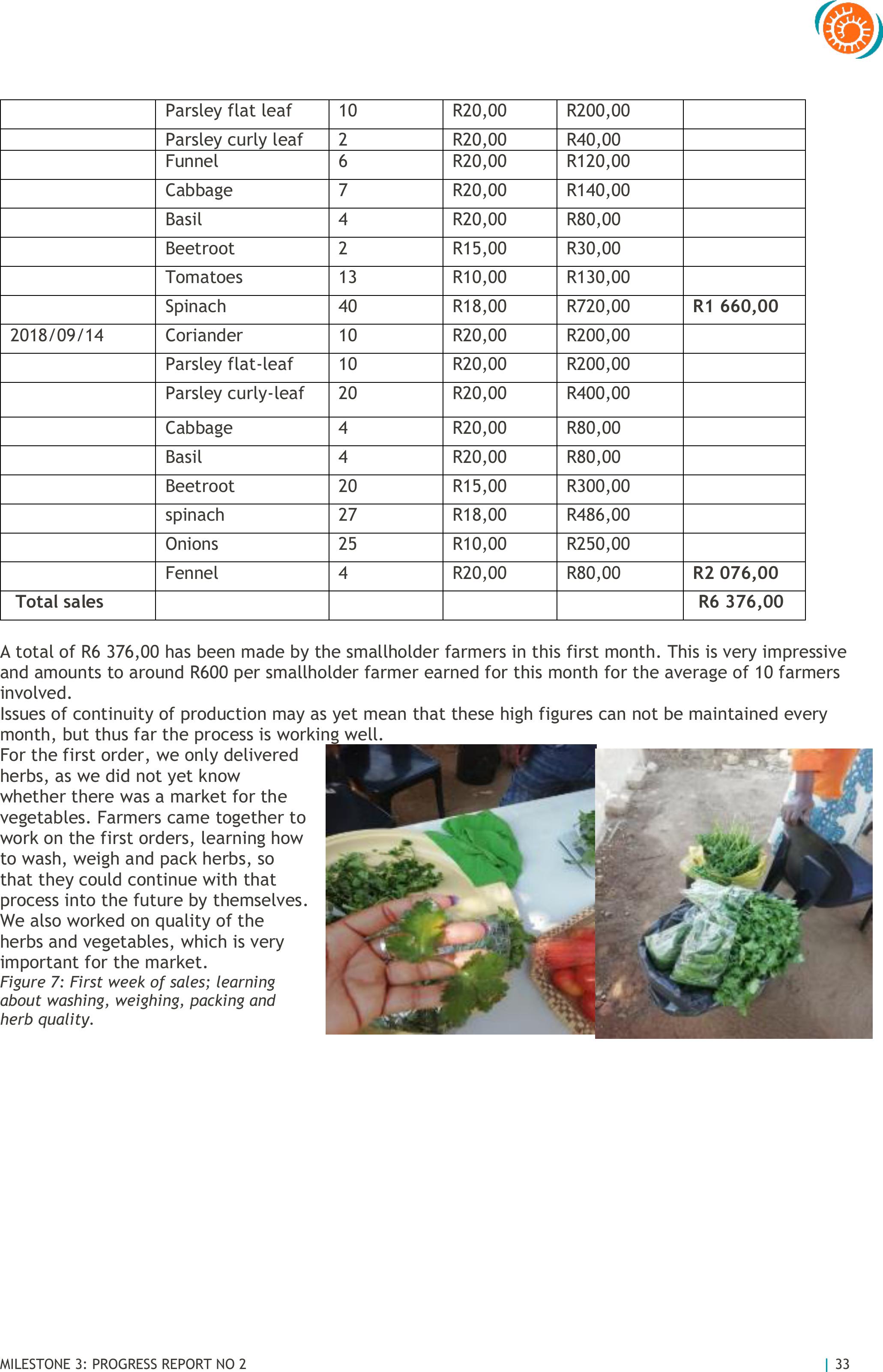
MILESTONE 3: PROGRESS REPORT NO 2
| 33
Parsley flat leaf
10
R20,00
R200,00
Parsley curly leaf
2
R20,00
R40,00
Funnel
6
R20,00
R120,00
Cabbage
7
R20,00
R140,00
Basil
4
R20,00
R80,00
Beetroot
2
R15,00
R30,00
Tomatoes
13
R10,00
R130,00
Spinach
40
R18,00
R720,00
R1 660,00
2018/09/14
Coriander
10
R20,00
R200,00
Parsley flat-leaf
10
R20,00
R200,00
Parsley curly-leaf
20
R20,00
R400,00
Cabbage
4
R20,00
R80,00
Basil
4
R20,00
R80,00
Beetroot
20
R15,00
R300,00
spinach
27
R18,00
R486,00
Onions
25
R10,00
R250,00
Fennel
4
R20,00
R80,00
R2 076,00
Total sales
R6 376,00
A total of R6 376,00 has been made by the smallholder farmers in this first month. This is very impressive
and amounts to around R600 per smallholder farmer earned for this month for the average of 10 farmers
involved.
Issues of continuity of production may as yet mean that these high figures can not be maintained every
month, but thus far the process is working well.
For the first order, we only delivered
herbs, as we did not yet know
whether there was a market for the
vegetables. Farmers came together to
work on the first orders, learning how
to wash, weigh and pack herbs, so
that they could continue with that
process into the future by themselves.
We also worked on quality of the
herbs and vegetables, which is very
important for the market.
Figure 7: First week of sales; learning
about washing, weighing, packing and
herb quality.
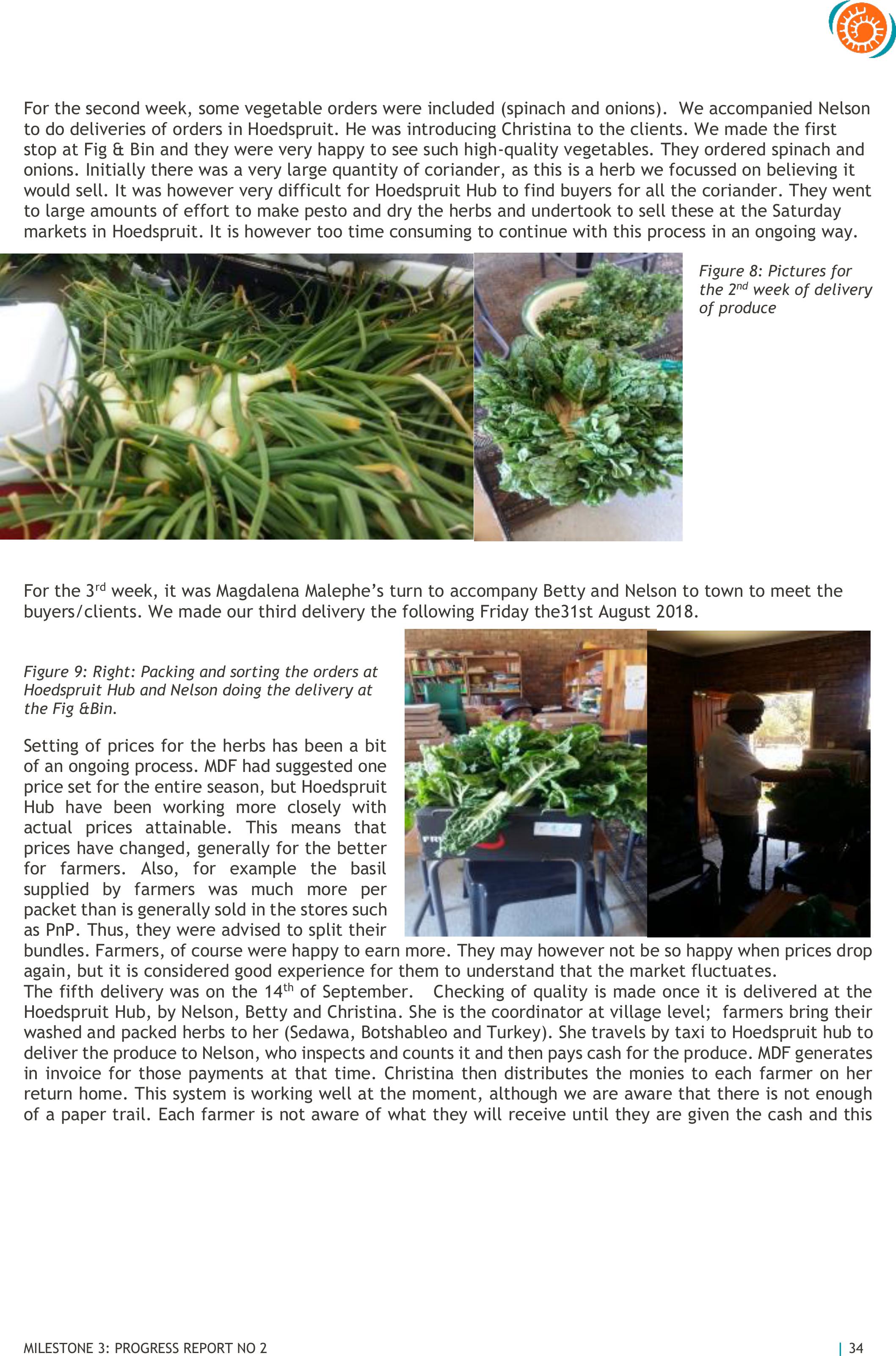
MILESTONE 3: PROGRESS REPORT NO 2
| 34
For the second week, some vegetable orders were included (spinach and onions). We accompanied Nelson
to do deliveries of orders in Hoedspruit. He was introducing Christina to the clients. We made the first
stop at Fig & Bin and they were very happy to see such high-quality vegetables. They ordered spinach and
onions. Initially there was a very large quantity of coriander, as this is a herb we focussed on believing it
would sell. It was however very difficult for Hoedspruit Hub to find buyers for all the coriander. They went
to large amounts of effort to make pesto and dry the herbs and undertook to sell these at the Saturday
markets in Hoedspruit. It is however too time consuming to continue with this process in an ongoing way.
Figure 8: Pictures for
the 2ndweek of delivery
of produce
For the 3rdweek, it was Magdalena Malephe’s turn to accompany Betty and Nelson to town to meet the
buyers/clients. We made our third delivery the following Friday the31st August 2018.
Figure 9: Right: Packing and sorting the orders at
Hoedspruit Hub and Nelson doing the delivery at
the Fig &Bin.
Setting of prices for the herbs has been a bit
of an ongoing process. MDF had suggested one
price set for the entire season, but Hoedspruit
Hub have been working more closely with
actual prices attainable. This means that
prices have changed, generally for the better
for farmers. Also, for example the basil
supplied by farmers was much more per
packet than is generally sold in the stores such
as PnP. Thus, they were advised to split their
bundles. Farmers, of course were happy toearn more. They may however not be so happy when prices drop
again, but it is considered good experience for them to understand that the market fluctuates.
The fifth delivery wason the 14thof September. Checking of quality ismade once it is delivered at the
Hoedspruit Hub, by Nelson, Betty and Christina. She is the coordinator at village level; farmers bring their
washed and packed herbs to her (Sedawa, Botshableo and Turkey). She travels by taxi to Hoedspruit hub to
deliver the produce to Nelson, who inspects and counts it and then pays cash forthe produce. MDF generates
in invoice for those payments at that time. Christina then distributes the monies to each farmer on her
return home. This system is working well at the moment, although we are aware that there is not enough
of apaper trail. Each farmer is not aware of what they will receive until they are given the cash and this
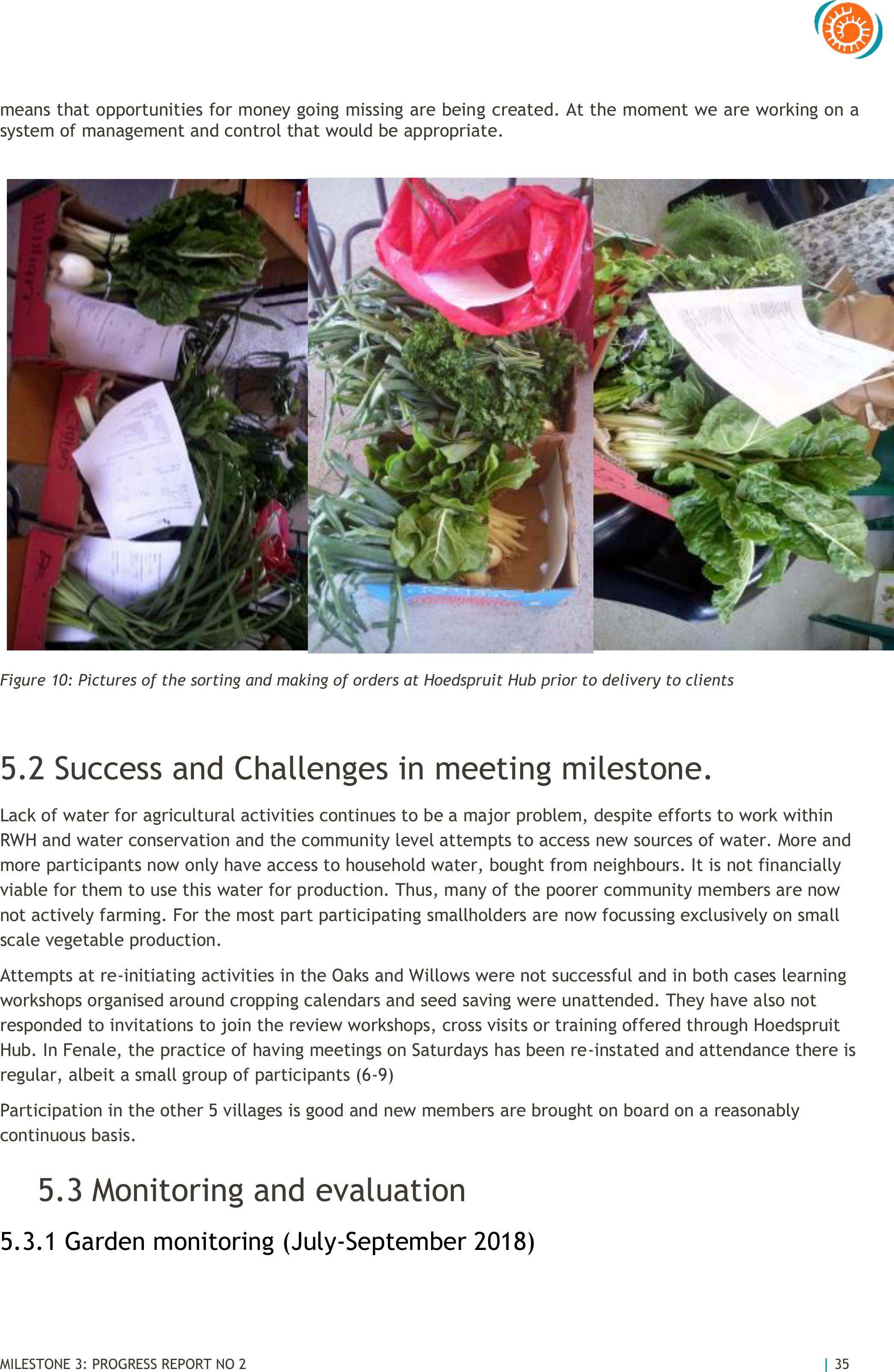
MILESTONE 3: PROGRESS REPORT NO 2
| 35
means that opportunities for money going missing are being created. At the moment we are working on a
system of management and control that would be appropriate.
Figure 10: Pictures of the sorting and making of orders at Hoedspruit Hub prior to delivery to clients
5.2Success and Challenges in meeting milestone.
Lack of water for agricultural activities continues to be a major problem, despite efforts to work within
RWH and water conservation and the community level attempts to access new sources of water. More and
more participants now only have access to household water, bought from neighbours. It is not financially
viable for them to use this water for production. Thus, many of the poorer community members are now
not actively farming. For the most part participating smallholders are now focussing exclusively on small
scale vegetable production.
Attempts at re-initiating activities in the Oaks and Willows were not successful and in both cases learning
workshops organised around cropping calendars and seed saving were unattended. They have also not
responded to invitations to join the review workshops, cross visits or training offered through Hoedspruit
Hub. In Fenale, the practice of having meetings on Saturdays has been re-instated and attendance there is
regular, albeit a small group of participants (6-9)
Participation in the other 5 villages is good and new members are brought on board on a reasonably
continuous basis.
5.3Monitoring and evaluation
5.3.1Garden monitoring (July-September 2018)
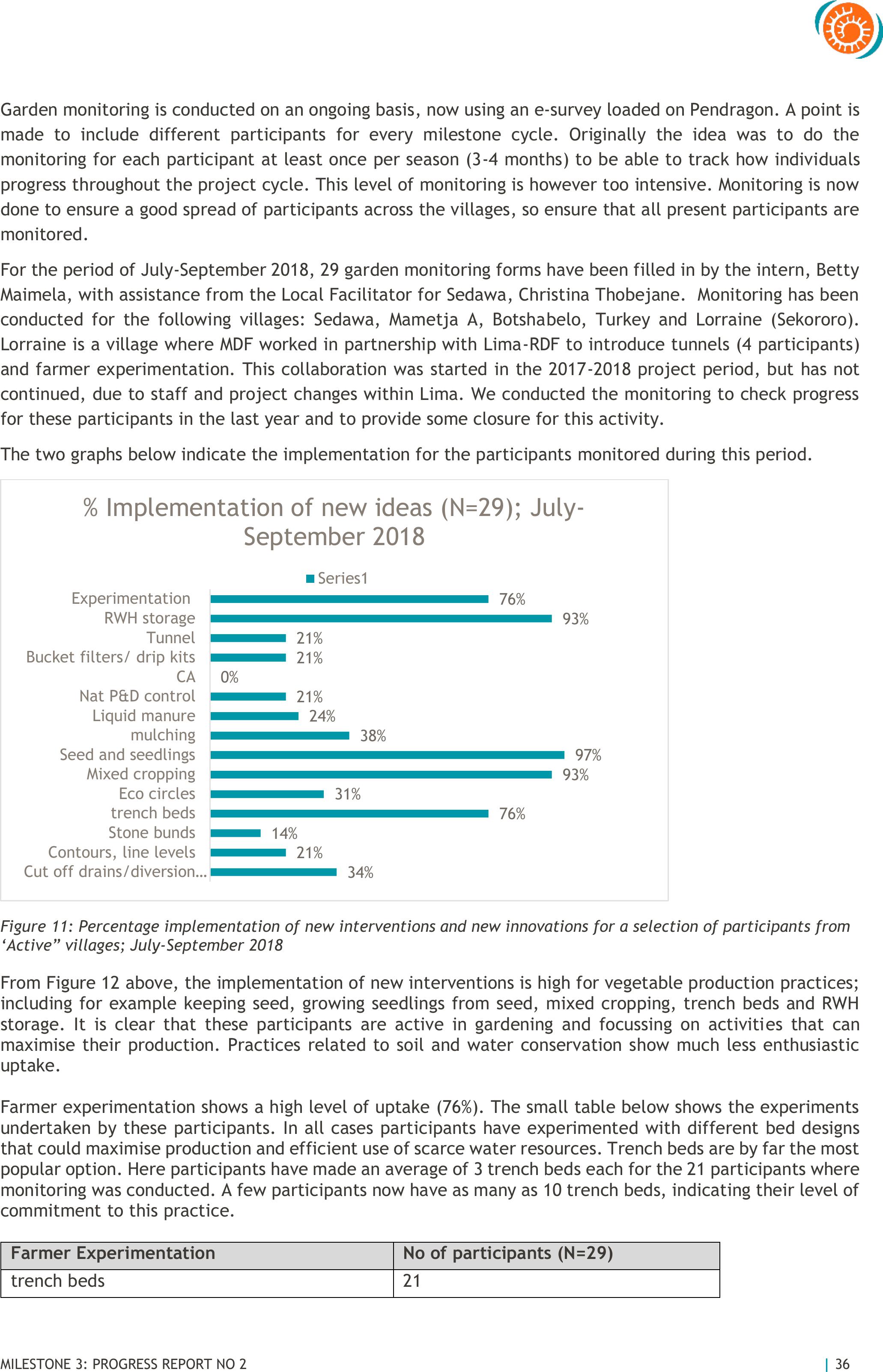
MILESTONE 3: PROGRESS REPORT NO 2
| 36
Garden monitoring is conducted on an ongoing basis, now using an e-survey loaded on Pendragon. A point is
made to include different participants for every milestone cycle. Originally the idea was to do the
monitoring for each participant at least once per season (3-4 months) to be able to track how individuals
progress throughout the project cycle. This level of monitoring is however too intensive. Monitoring is now
done to ensure a good spread of participants across the villages, so ensure that all present participants are
monitored.
For the period of July-September 2018, 29 garden monitoring forms have been filled in by the intern, Betty
Maimela, with assistance from the Local Facilitator for Sedawa, Christina Thobejane. Monitoring has been
conducted for the following villages: Sedawa, Mametja A, Botshabelo, Turkey and Lorraine (Sekororo).
Lorraine is a village where MDF worked inpartnership with Lima-RDF to introduce tunnels (4 participants)
and farmer experimentation. This collaboration wasstarted in the 2017-2018 project period, but has not
continued, due to staff and project changes within Lima. We conducted the monitoring tocheck progress
for these participants in the last year and to provide some closure for this activity.
The two graphs below indicate the implementation for the participants monitored during this period.
Figure 11: Percentage implementation of new interventions and new innovations for a selection of participants from
‘Active” villages; July-September 2018
From Figure 12 above, the implementation of new interventions is high for vegetable production practices;
including for example keeping seed, growing seedlings from seed,mixed cropping, trench beds and RWH
storage. It is clear that these participants are active in gardening and focussing on activities that can
maximise their production. Practices related to soil and water conservation show much less enthusiastic
uptake.
Farmer experimentation shows a high level of uptake (76%). The small table below shows the experiments
undertaken by these participants. In all cases participants have experimented with different bed designs
that could maximise production and efficient use of scarce water resources. Trench beds are by far the most
popular option. Here participants have made an average of 3 trench beds each for the 21participants where
monitoring was conducted.A few participants now have as many as 10 trench beds, indicating their level of
commitment to this practice.
Farmer Experimentation
No of participants (N=29)
trench beds
21
34%
21%
14%
76%
31%
93%
97%
38%
24%
21%
0%
21%
21%
93%
76%
Cut off drains/diversion…
Contours, line levels
Stone bunds
trench beds
Eco circles
Mixed cropping
Seed and seedlings
mulching
Liquid manure
Nat P&D control
CA
Bucket filters/ drip kits
Tunnel
RWH storage
Experimentation
% Implementation of new ideas (N=29); July-
September 2018
Series1
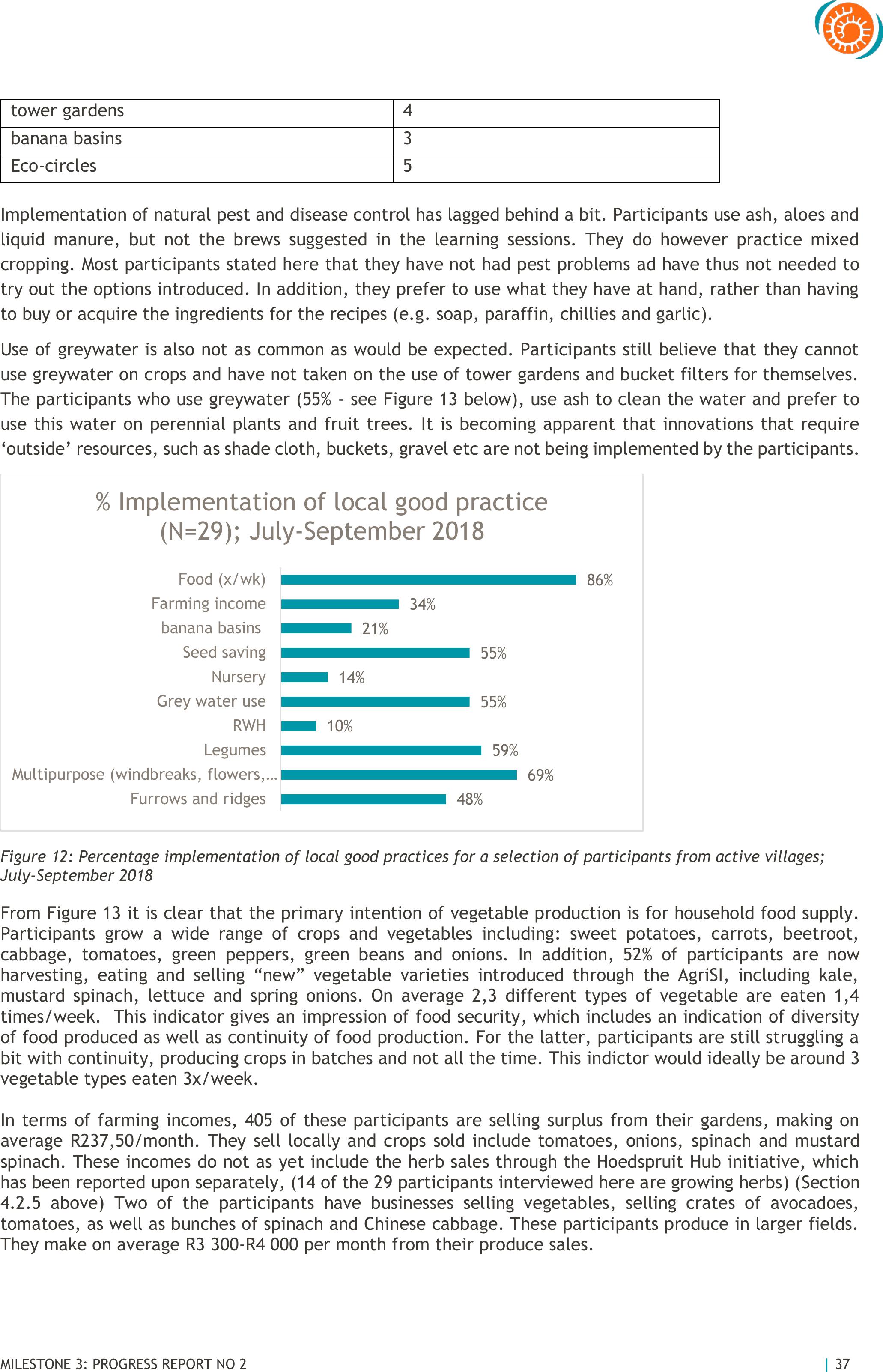
MILESTONE 3: PROGRESS REPORT NO 2
| 37
tower gardens
4
banana basins
3
Eco-circles
5
Implementation of natural pest and disease control has lagged behind a bit. Participants use ash, aloes and
liquid manure, but not the brews suggested in the learning sessions. They dohowever practice mixed
cropping. Most participants stated here that they have not hadpest problems ad have thus not needed to
try out the options introduced. In addition, they prefer to use what they have at hand, rather than having
to buy or acquire the ingredients for the recipes (e.g. soap, paraffin, chillies and garlic).
Use of greywater is also not as common as would be expected. Participants still believe that they cannot
use greywater on crops and have not taken on the use of tower gardens and bucket filters for themselves.
The participants who use greywater (55% - see Figure 13 below), use ash toclean the water and prefer to
use this water on perennial plants and fruit trees. It is becoming apparent that innovations that require
‘outside’ resources, such as shade cloth, buckets, gravel etc are not being implemented by the participants.
Figure 12: Percentage implementation of local good practices for a selection of participants from active villages;
July-September 2018
From Figure 13it is clear that the primary intention of vegetable production is for household food supply.
Participants grow a wide range of crops and vegetables including: sweet potatoes, carrots, beetroot,
cabbage, tomatoes, green peppers, green beans and onions. In addition, 52% of participants are now
harvesting, eating and selling “new” vegetable varieties introduced through the AgriSI, including kale,
mustard spinach, lettuce and springonions. Onaverage 2,3 different types of vegetable are eaten 1,4
times/week. This indicator gives an impression of food security, which includes an indication of diversity
of food produced as well as continuity of food production. For the latter, participants are still struggling a
bit with continuity, producing crops in batches and not all the time. This indictor would ideally be around 3
vegetable types eaten 3x/week.
In terms of farming incomes, 405 of these participants are selling surplus from their gardens, making on
average R237,50/month. They sell locally and crops sold include tomatoes, onions, spinach and mustard
spinach. These incomesdonot as yet include theherb sales throughthe Hoedspruit Hub initiative,which
has been reported upon separately, (14 of the 29 participants interviewed here are growing herbs) (Section
4.2.5 above) Two of the participants have businesses selling vegetables, selling crates of avocadoes,
tomatoes, as well as bunches of spinach and Chinese cabbage. These participants produce in larger fields.
They make on average R3 300-R4 000 per month from their produce sales.
48%
69%
59%
10%
55%
14%
55%
21%
34%
86%
Furrows and ridges
Multipurpose (windbreaks, flowers,…
Legumes
RWH
Grey water use
Nursery
Seed saving
banana basins
Farming income
Food (x/wk)
% Implementation of local good practice
(N=29); July-September 2018
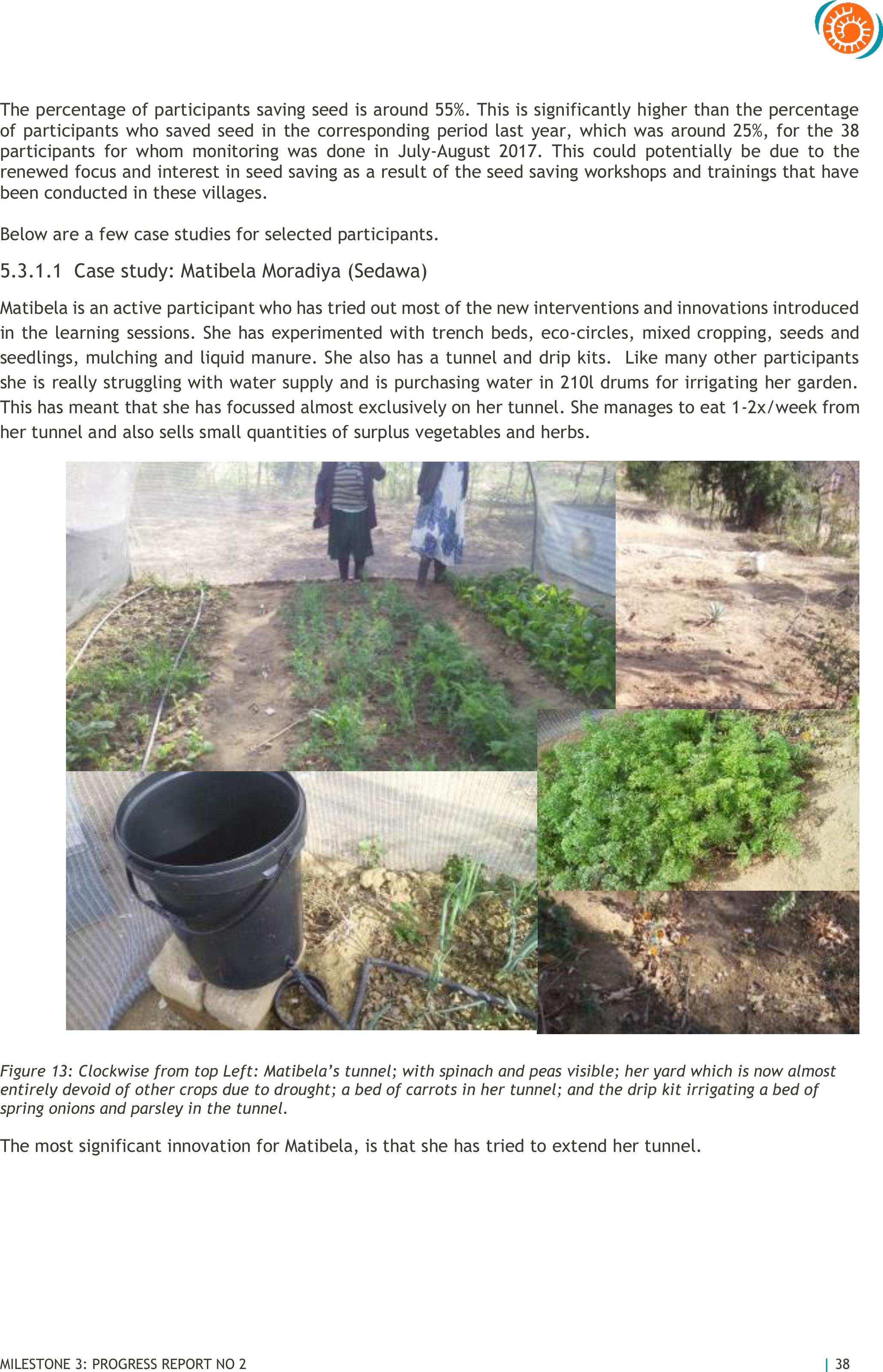
MILESTONE 3: PROGRESS REPORT NO 2
| 38
The percentage of participants saving seed is around 55%. This is significantly higher thanthe percentage
of participants who saved seed in the corresponding period last year, which was around 25%, for the 38
participants for whom monitoring wasdone in July-August 2017. This could potentially be due to the
renewed focus and interest in seed saving as a result of the seed saving workshops and trainings that have
been conducted in these villages.
Below are a few case studies for selected participants.
5.3.1.1Case study: Matibela Moradiya (Sedawa)
Matibela is an active participant who has tried out most of the new interventions and innovations introduced
in the learning sessions. She hasexperimented with trench beds, eco-circles, mixed cropping, seeds and
seedlings, mulching and liquid manure. She also hasa tunnel and drip kits. Like many other participants
she is really struggling with water supply and is purchasing water in 210l drums for irrigating her garden.
This has meant that she has focussed almost exclusively on her tunnel. She manages to eat 1-2x/week from
her tunnel and also sells small quantities of surplus vegetables and herbs.
Figure 13: Clockwise from top Left: Matibela’s tunnel; with spinach and peas visible; her yard which is now almost
entirely devoid of other crops due to drought; a bed of carrots in her tunnel; and the drip kit irrigating a bed of
spring onions and parsley in the tunnel.
The most significant innovation for Matibela, is that she has tried to extend her tunnel.
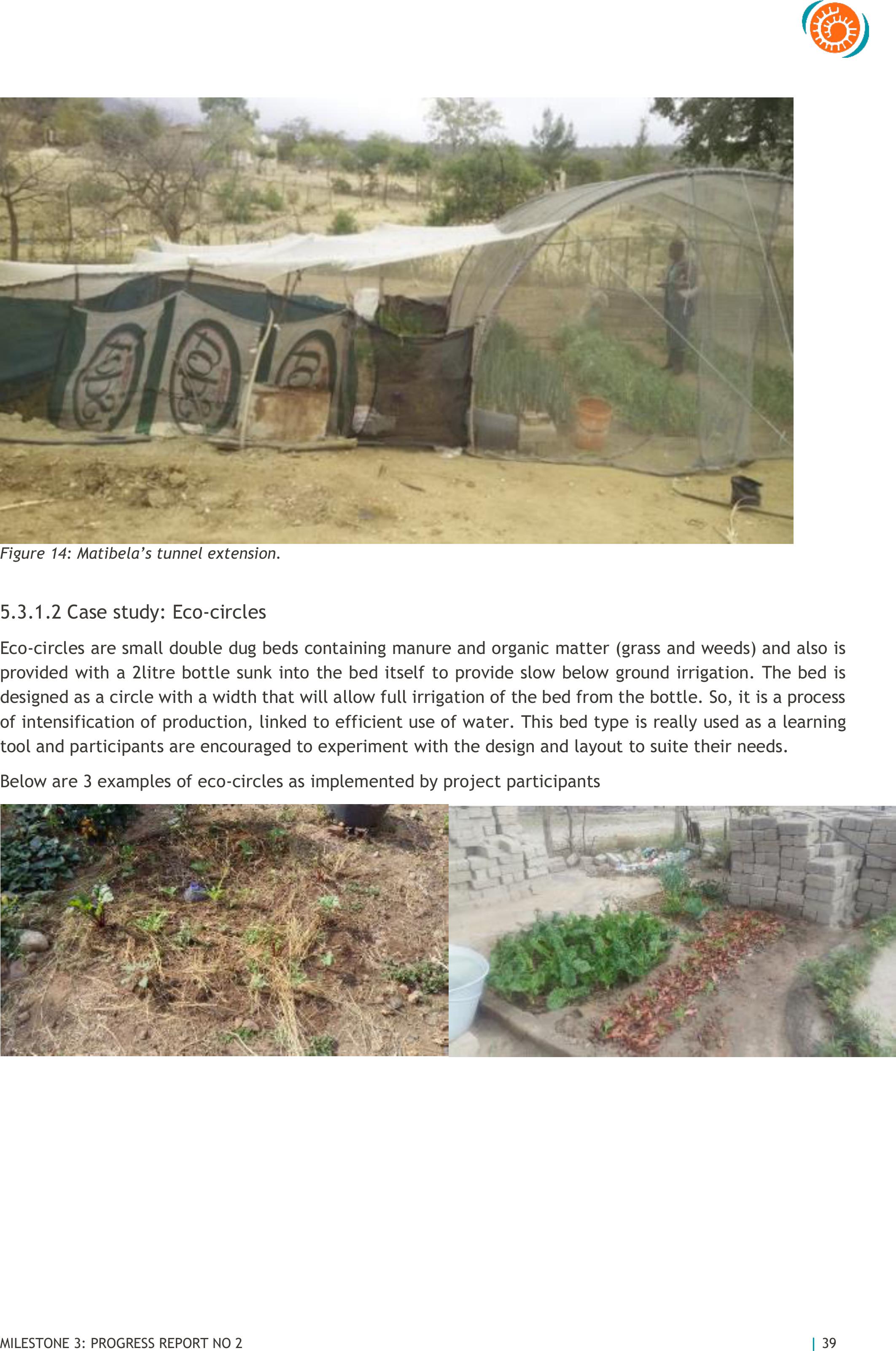
MILESTONE 3: PROGRESS REPORT NO 2
| 39
Figure 14: Matibela’s tunnel extension.
5.3.1.2Case study: Eco-circles
Eco-circles are small double dug beds containing manure and organic matter (grass and weeds) and alsois
provided with a 2litre bottle sunk into the bed itself to provide slow below ground irrigation. The bed is
designed as a circle with a width that will allow full irrigation of the bed from the bottle. So, it is a process
of intensification of production, linked to efficient use of water. This bed typeis really used asa learning
tool and participants are encouraged to experiment with the design and layout to suite their needs.
Below are 3 examples of eco-circles as implemented by project participants

MILESTONE 3: PROGRESS REPORT NO 2
| 40
Figure 15: Above left; Josephina Malepe’s eco-circle (Sedawa)- she has used cut grass as mulch. Above right;
Makgalangakhe Mohale’s (Turkey 2) eco-circle. She has made a sunken bed here and integrated it with another bed
and a furrow and ridge. She has used leaves as mulch.
Figure 16: Right and far
right; Phelecia Shaai’s
9Turkey 1) eco-circle.
She has also used an
adaption of sunken beds
and has included the
eco-circle in her overall
garden design. On the
far right are her trench
beds (not planted yet)
5.3.1.3Sekororo (Lorraine) case study
Sekororo (Lorraine), the joint implementation site with Lima -RDF, has four participants experimenting
with tunnels and a number of other gardening practices of the four participants, three have borehole
water in their yards. Below are some pictures for two of the participants.
Figure 17: Lydia Setshebu’s tunnel. She has four *4.5m trench beds (3 in her tunnel and one outside) where she
planted spinach, beetroot, kale and tomatoes.
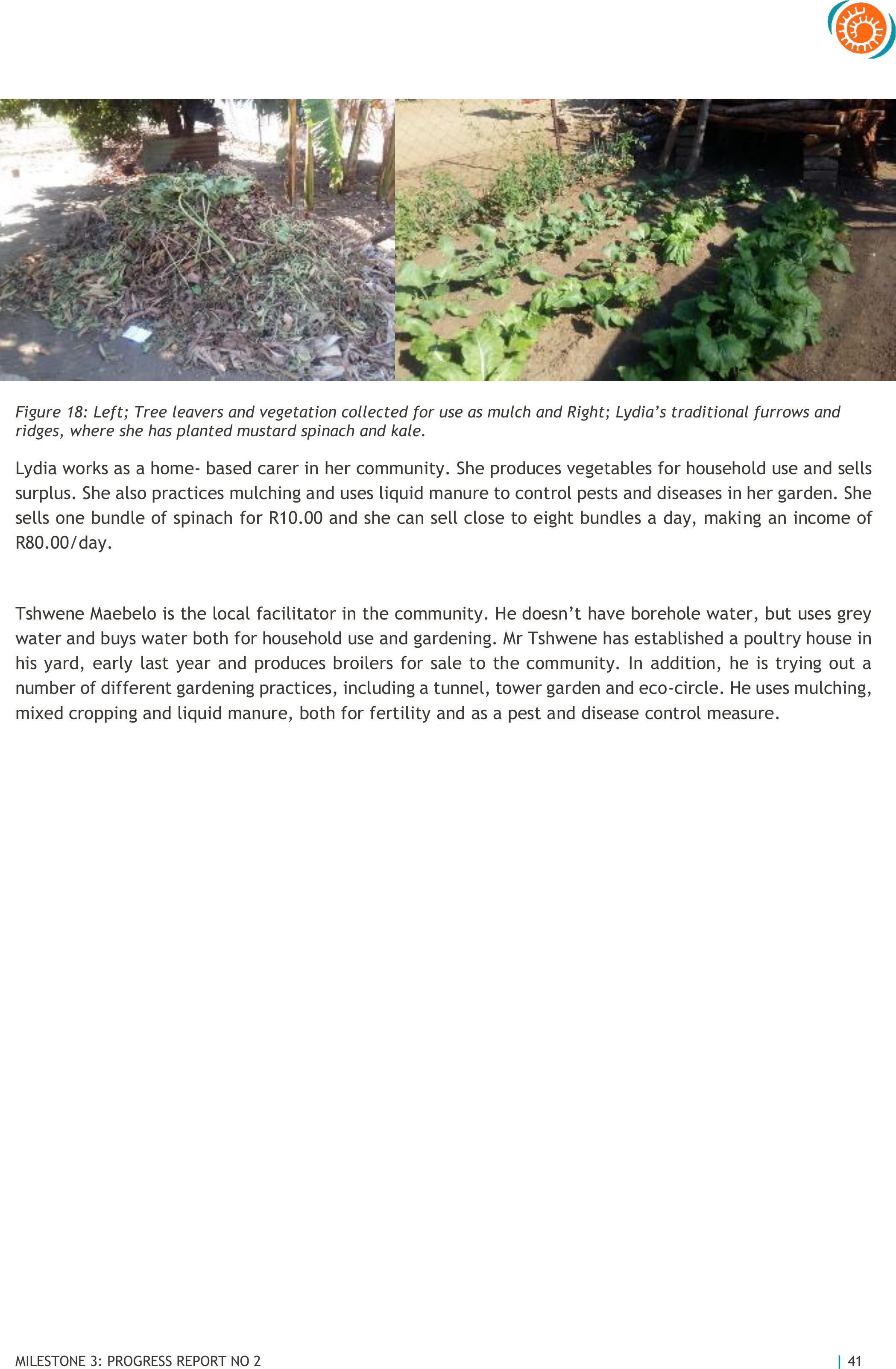
MILESTONE 3: PROGRESS REPORT NO 2
| 41
Figure 18: Left; Tree leavers and vegetation collected for use as mulch and Right; Lydia’s traditional furrows and
ridges, where she has planted mustard spinach and kale.
Lydia works as a home- based carer in her community. She produces vegetables for household use and sells
surplus. She also practices mulching and uses liquid manure to control pests and diseases in her garden. She
sells one bundle of spinach for R10.00and she can sell close to eight bundles a day, making an income of
R80.00/day.
Tshwene Maebelo is the local facilitator in the community. He doesn’t have borehole water, but uses grey
water and buys water both for household use and gardening. Mr Tshwene has established a poultry house in
his yard, early last year and produces broilers for sale to the community. In addition, he is trying out a
number of different gardening practices, including atunnel, tower garden and eco-circle. He uses mulching,
mixed cropping and liquid manure, both for fertility and as a pest and disease control measure.
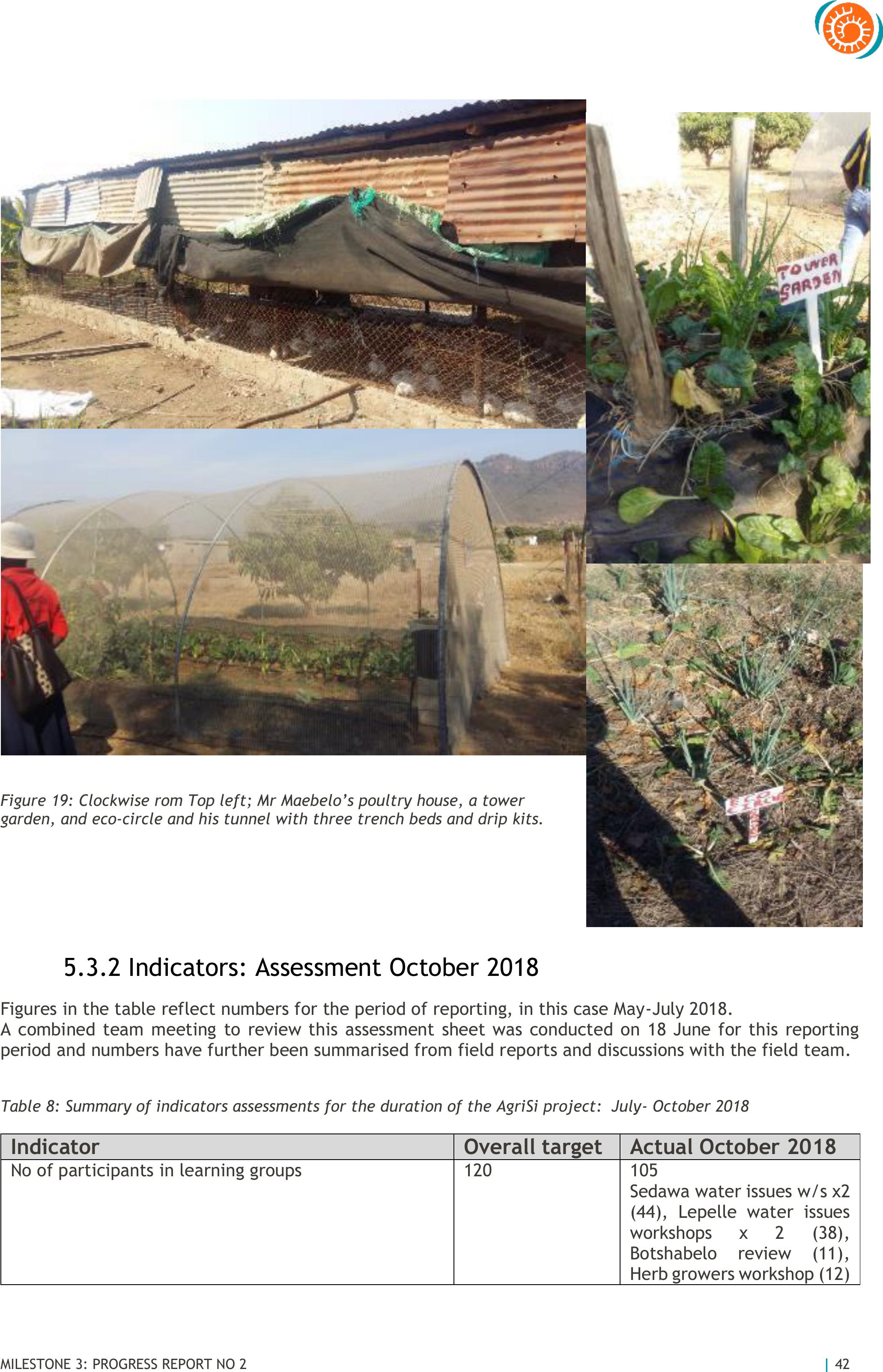
MILESTONE 3: PROGRESS REPORT NO 2
| 42
Figure 19: Clockwise rom Top left; Mr Maebelo’s poultry house, a tower
garden, and eco-circle and his tunnel with three trench beds and drip kits.
5.3.2Indicators: Assessment October 2018
Figures in the table reflect numbers for the period of reporting, in this case May-July 2018.
A combined teammeeting toreview this assessment sheet was conducted on 18June for this reporting
period and numbers have further been summarised from field reports and discussions with the field team.
Table 8: Summary of indicators assessments for the duration of the AgriSi project: July- October 2018
Indicator
Overall target
Actual October 2018
No of participants in learning groups
120
105
Sedawa water issues w/s x2
(44), Lepelle water issues
workshops x 2(38),
Botshabelo review (11),
Herb growers workshop (12)
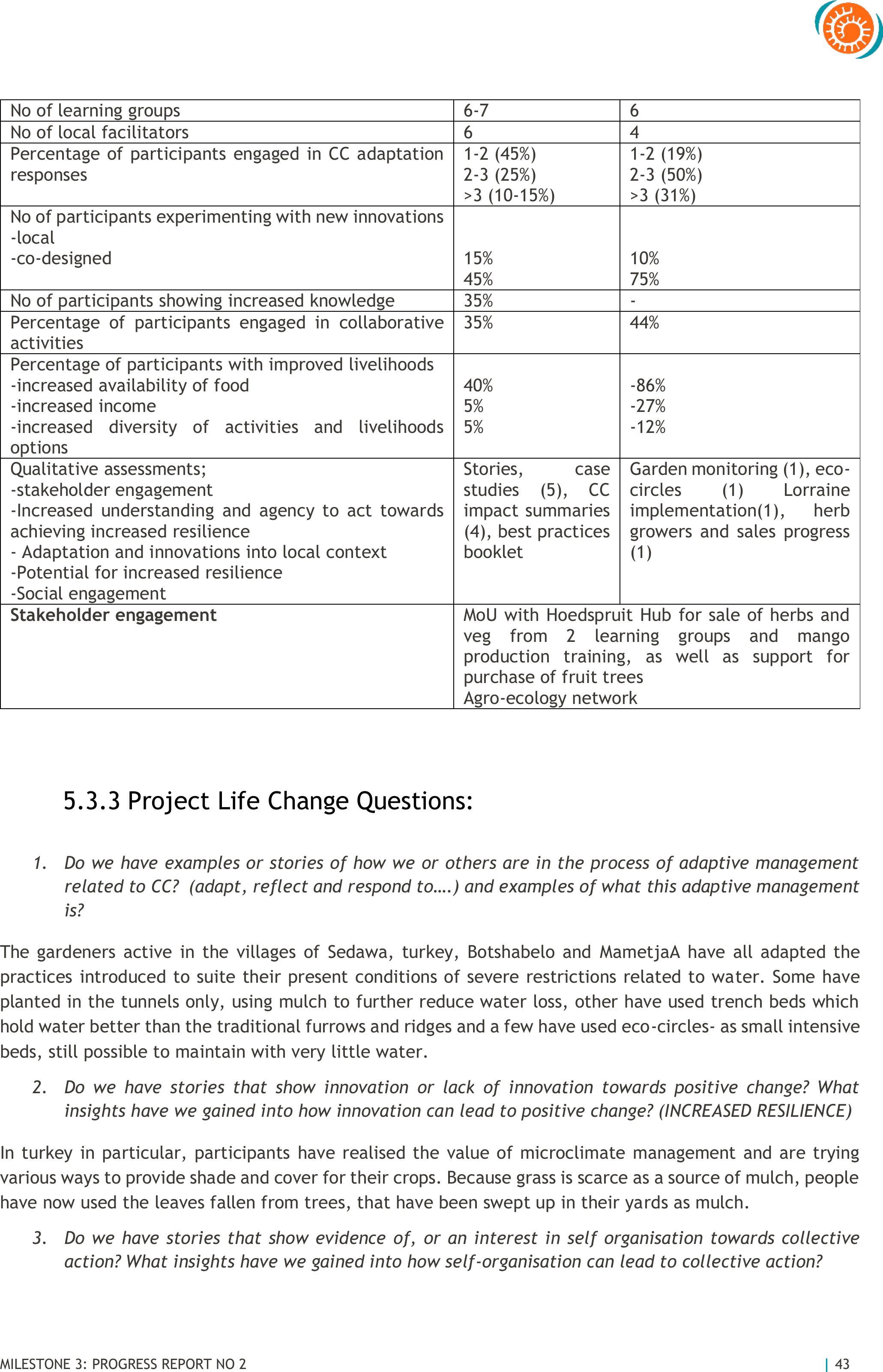
MILESTONE 3: PROGRESS REPORT NO 2
| 43
No of learning groups
6-7
6
No of local facilitators
6
4
Percentage of participants engaged in CC adaptation
responses
1-2 (45%)
2-3 (25%)
>3 (10-15%)
1-2 (19%)
2-3 (50%)
>3 (31%)
No of participants experimenting with new innovations
-local
-co-designed
15%
45%
10%
75%
No of participants showing increased knowledge
35%
-
Percentage of participants engaged in collaborative
activities
35%
44%
Percentage of participants with improved livelihoods
-increased availability of food
-increased income
-increased diversity of activities and livelihoods
options
40%
5%
5%
-86%
-27%
-12%
Qualitative assessments;
-stakeholder engagement
-Increased understanding and agency to act towards
achieving increased resilience
- Adaptation and innovations into local context
-Potential for increased resilience
-Social engagement
Stories, case
studies (5), CC
impact summaries
(4), best practices
booklet
Garden monitoring (1), eco-
circles (1) Lorraine
implementation(1), herb
growers and sales progress
(1)
Stakeholder engagement
MoU with Hoedspruit Hub for sale of herbs and
veg from 2 learning groups and mango
production training, as well as support for
purchase of fruit trees
Agro-ecology network
5.3.3Project Life Change Questions:
1.Do wehave examples or stories of how we or others arein the process of adaptive management
related to CC? (adapt, reflect and respond to….) and examples of what this adaptive management
is?
The gardeners active in the villages of Sedawa, turkey, Botshabelo and MametjaA have all adapted the
practices introduced to suite their present conditions of severe restrictions related to water. Somehave
planted in the tunnels only, using mulch to further reduce water loss, other have used trench beds which
hold water better than the traditional furrows and ridges and a few have used eco-circles- as small intensive
beds, still possible to maintain with very little water.
2.Do we have stories that show innovationor lack of innovationtowards positive change? What
insights have we gained into how innovation can lead to positive change? (INCREASED RESILIENCE)
In turkey in particular, participantshave realised the value of microclimate management and are trying
various ways to provide shade and cover for their crops. Because grass is scarce as a source of mulch, people
have now used the leaves fallen from trees, that have been swept up in their yards as mulch.
3.Do we have stories that show evidence of, or an interest in self organisation towards collective
action? What insights have we gained into how self-organisation can lead to collective action?

MILESTONE 3: PROGRESS REPORT NO 2
| 44
The work with the two water committees (Lepelle and sedawa) is now ongoing in support of their vision and
actions for provision of agricultural water for themselves. In turkey, community members are a bit further
along with this process and have divided themselves into groups of roughly 10 households which work
together to procure a source in the mountains and bring a pipe closer to their homesteads;which they share.
Participants in Sedawa in particular are very keen to use their community video shot through the
participatory video process to lobby the stakeholders in the area. They want to “go all the way to the top”
as they believe their local officials are too corrupt to respond to their requests and needs.
Participants in Sedawa have also specifically spoken to the Botshabelo farther and son team whohave et up
a local water scheme in that village to glean advice and learnings from them for this process.
4.Do we have stories to showthat learning together is happening or that there is an interest in
learning together? What insights have we gained about how to learn together?
Further sharing has happened in this period around the building of tunnels, which some groups have
mastered better than others and also around the production and packaging of herbs and vegetables for sale
to shops and restaurants in Hoedspruit
5.3.4Work Plan for next period (10 October- 15 December 2018).
1.Garden monitoring to be focussed on:
•A comparison of participants with and without tunnels (20 of each), as a case study to
quantify the impact of tunnels on production
•Lepelle, Finale, The Oaks and Willows, to assess implementation of new ideas and
innovations by participants from these villages. Participation from these groups has
been limited in the 2018-2019 project period,
2.Re-introduction of Natural Pest and disease control options; including growing of pest repellent
plants and crops
3.Re-introduction of greywater management; different options, including use of moringa seed for
cleaning water prior to use.
4.Continuation with water committees and water provision projects in Sedawa and Lepelle – to
include a borehole survey in Sedawa, further workshops for planning and collection of
contributions form participants, writing of funding proposals by MDF to source co-funding.
5.Learning session in Organic Mango production and supply of subsidised fruit trees in Lepelle.
6.Continuation of herb and vegetable production for sale through the Hoedspruit Hub partnership
process. The next round of seedlings was supplied towards the end of September and
participants are also growing crops from seed.
7.Learning sessions; review of S&WC and CSA, for all groups (1 day), Start on Poultry production
training in Botshabelo, Turkey, Sedawa).
8.Cluster network session; Impacts of activities
9.Agroecology network- sessions on a CoP for best practices in CSA
10.Use of participatory video as a tool to build agency in the villages for CCA activities and
communicate successes and issues with relevant stakeholders
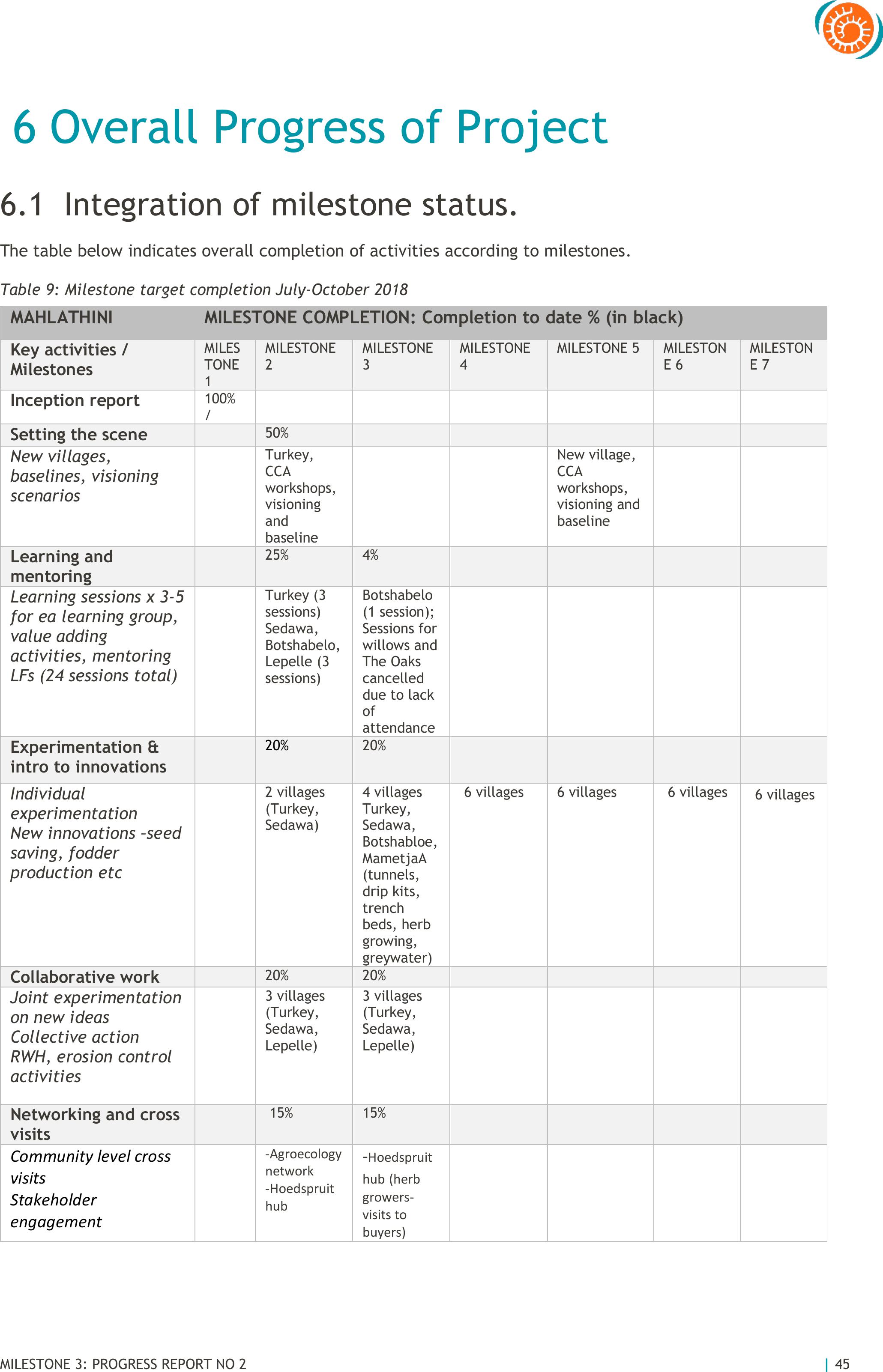
MILESTONE 3: PROGRESS REPORT NO 2
| 45
6Overall Progress of Project
6.1 Integration of milestone status.
The table below indicates overall completion of activities according to milestones.
Table 9: Milestone target completion July-October 2018
MAHLATHINI
MILESTONE COMPLETION: Completion to date % (in black)
Key activities /
Milestones
MILES
TONE
1
MILESTONE
2
MILESTONE
3
MILESTONE
4
MILESTONE 5
MILESTON
E 6
MILESTON
E 7
Inception report
100%
/
Setting the scene
50%
New villages,
baselines, visioning
scenarios
Turkey,
CCA
workshops,
visioning
and
baseline
New village,
CCA
workshops,
visioning and
baseline
Learning and
mentoring
25%
4%
Learning sessions x 3-5
for ea learning group,
value adding
activities, mentoring
LFs (24 sessions total)
Turkey (3
sessions)
Sedawa,
Botshabelo,
Lepelle (3
sessions)
Botshabelo
(1 session);
Sessions for
willows and
The Oaks
cancelled
due to lack
of
attendance
Experimentation &
intro to innovations
20%
20%
Individual
experimentation
New innovations –seed
saving, fodder
production etc
2 villages
(Turkey,
Sedawa)
4 villages
Turkey,
Sedawa,
Botshabloe,
MametjaA
(tunnels,
drip kits,
trench
beds, herb
growing,
greywater)
6 villages
6 villages
6 villages
6 villages
Collaborative work
20%
20%
Joint experimentation
on new ideas
Collective action
RWH, erosion control
activities
3 villages
(Turkey,
Sedawa,
Lepelle)
3 villages
(Turkey,
Sedawa,
Lepelle)
Networking and cross
visits
15%
15%
Community level cross
visits
Stakeholder
engagement
-Agroecology
network
-Hoedspruit
hub
-Hoedspruit
hub(herb
growers-
visits to
buyers)
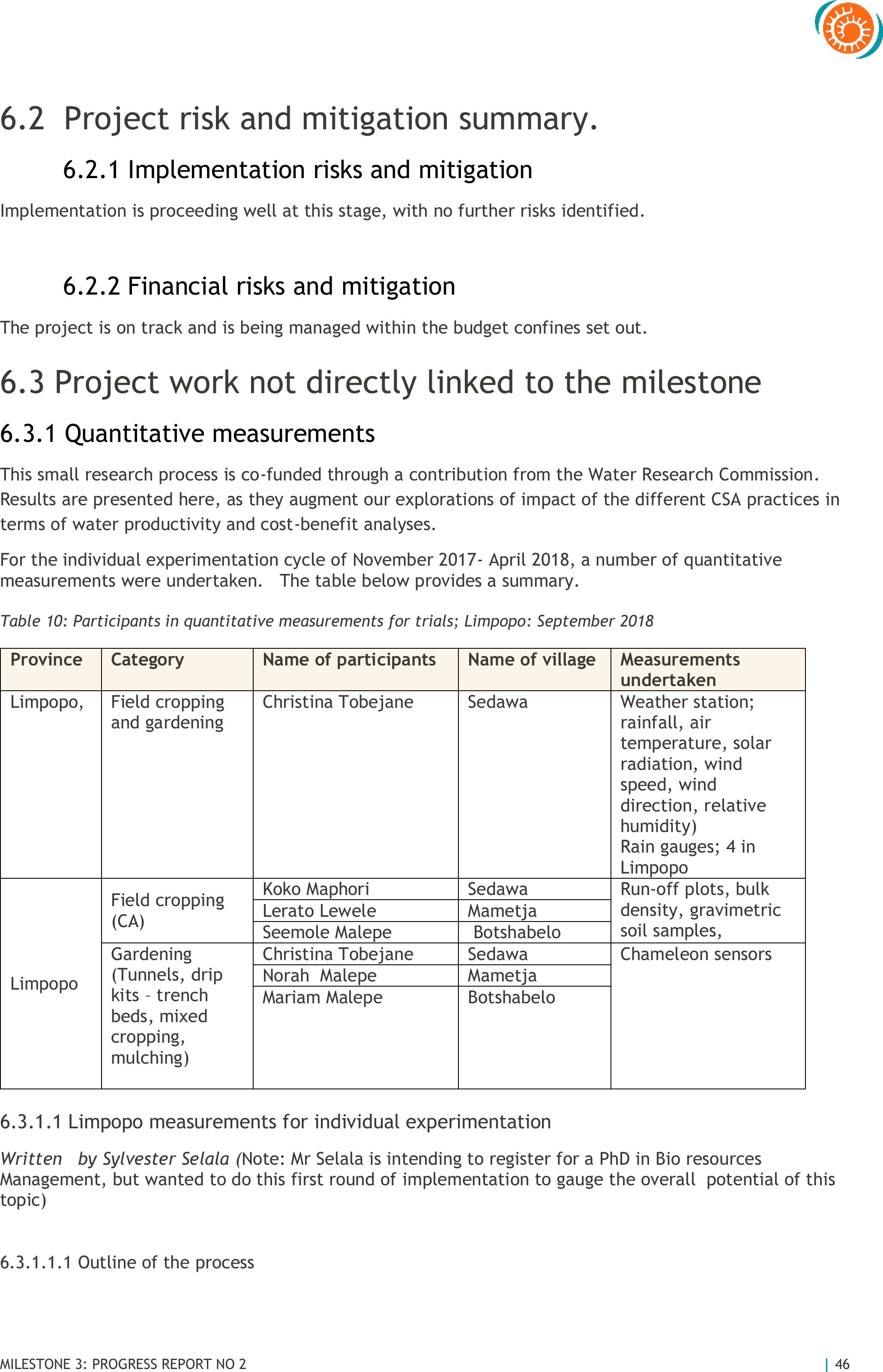
MILESTONE 3: PROGRESS REPORT NO 2
| 46
6.2 Project risk and mitigation summary.
6.2.1Implementation risks and mitigation
Implementation is proceeding well at this stage, with no further risks identified.
6.2.2Financial risks and mitigation
The project is on track and is being managed within the budget confines set out.
6.3Project work not directly linked to the milestone
6.3.1Quantitative measurements
This small research process is co-funded through a contribution from the Water Research Commission.
Results are presented here, as they augment our explorations of impact of the different CSA practices in
terms of water productivity and cost-benefit analyses.
For the individual experimentation cycle of November 2017- April 2018, a number of quantitative
measurements were undertaken. The table below provides a summary.
Table 10: Participants in quantitative measurements for trials; Limpopo: September 2018
Province
Category
Name of participants
Name of village
Measurements
undertaken
Limpopo,
Field cropping
and gardening
Christina Tobejane
Sedawa
Weather station;
rainfall, air
temperature, solar
radiation, wind
speed, wind
direction, relative
humidity)
Rain gauges; 4 in
Limpopo
Limpopo
Field cropping
(CA)
Koko Maphori
Sedawa
Run-off plots, bulk
density, gravimetric
soil samples,
Lerato Lewele
Mametja
Seemole Malepe
Botshabelo
Gardening
(Tunnels, drip
kits – trench
beds, mixed
cropping,
mulching)
Christina Tobejane
Sedawa
Chameleon sensors
Norah Malepe
Mametja
Mariam Malepe
Botshabelo
6.3.1.1Limpopo measurements for individual experimentation
Written by Sylvester Selala (Note: Mr Selala is intending to register for a PhD in Bio resources
Management, but wanted to do this first round of implementation to gauge the overall potential of this
topic)
6.3.1.1.1Outline of the process
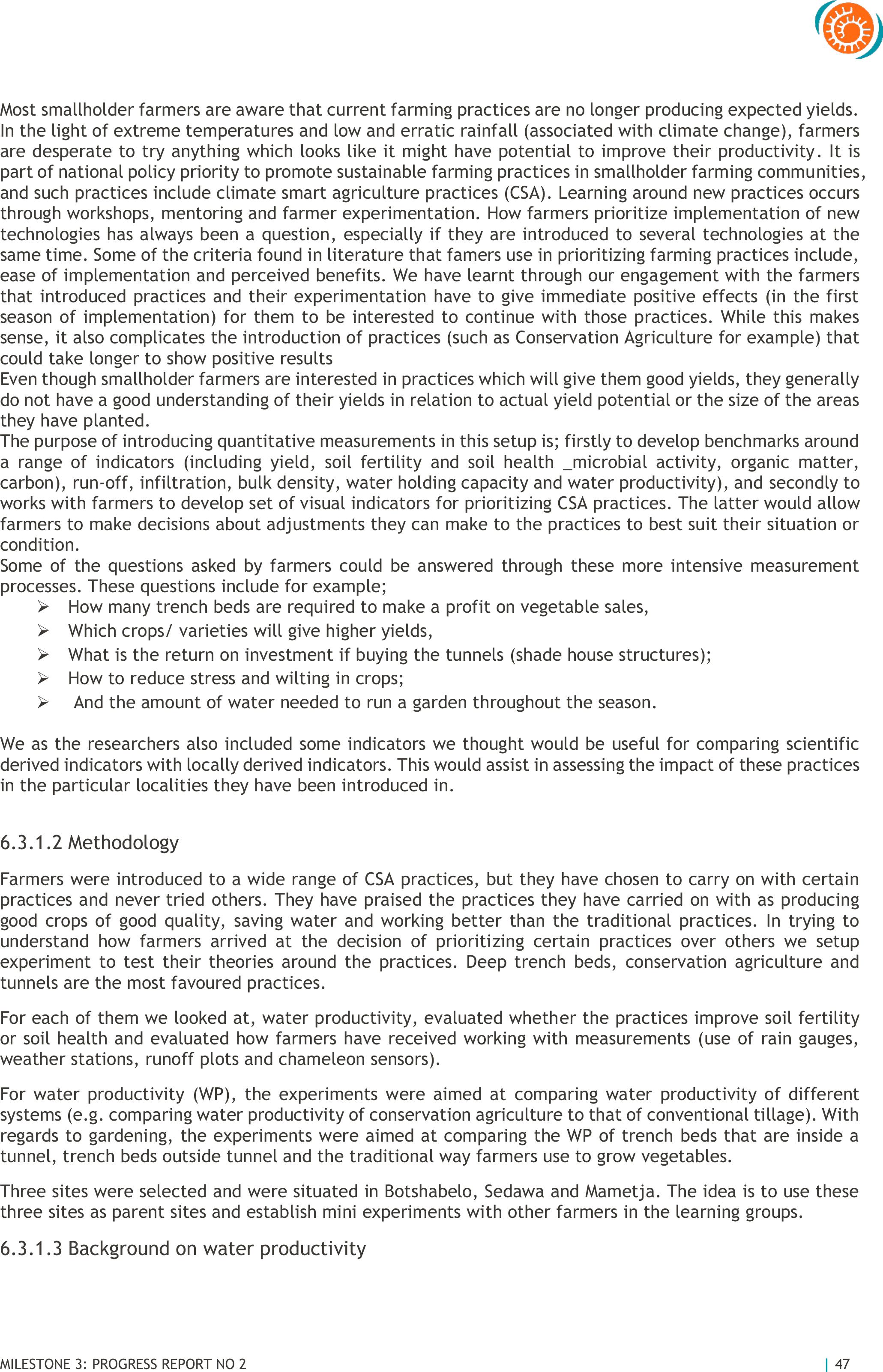
MILESTONE 3: PROGRESS REPORT NO 2
| 47
Most smallholder farmers are aware that current farming practices are no longer producing expected yields.
In the light of extreme temperatures and low and erratic rainfall (associated with climate change), farmers
are desperate to try anything whichlooks like it might havepotential to improve their productivity. It is
part of national policy priority to promote sustainable farming practices in smallholder farming communities,
and such practices include climate smart agriculture practices (CSA). Learning around new practices occurs
through workshops, mentoring and farmer experimentation. How farmers prioritize implementation of new
technologies hasalwaysbeen a question, especially if they are introduced to several technologies at the
same time. Some of the criteria found in literature that famers use in prioritizing farming practices include,
ease of implementation and perceived benefits. We have learnt through our engagement with the farmers
that introduced practices and their experimentationhave to give immediate positive effects (in the first
season of implementation) for them to be interested to continue with those practices. While this makes
sense, it also complicates the introduction of practices (such as Conservation Agriculture for example) that
could take longer to show positive results
Even though smallholder farmers are interested in practices which will give them good yields, they generally
do not have a good understanding of their yields in relation to actual yield potential or thesize of the areas
they have planted.
The purpose of introducing quantitative measurements in this setup is; firstly to develop benchmarksaround
a range of indicators (including yield, soil fertility and soil health _microbial activity, organic matter,
carbon), run-off, infiltration, bulk density, water holding capacity and water productivity), and secondly to
works with farmers to develop set of visual indicators for prioritizing CSA practices. The latter would allow
farmers to make decisions about adjustments they can make to the practices to best suit their situation or
condition.
Some of the questions asked by farmers could be answered through these more intensive measurement
processes. These questions include for example;
➢How many trench beds are required to make a profit on vegetable sales,
➢Which crops/ varieties will give higher yields,
➢What is the return on investment if buying the tunnels (shade house structures);
➢How to reduce stress and wilting in crops;
➢ And the amount of water needed to run a garden throughout the season.
We as the researchers alsoincluded some indicators we thought would be useful for comparing scientific
derived indicators with locally derived indicators. This would assist in assessing the impact of these practices
in the particular localities they have been introduced in.
6.3.1.2Methodology
Farmers were introduced toa wide range of CSA practices, but they have chosen to carry on with certain
practices and never triedothers. They have praised the practices they have carried on with as producing
good crops of good quality, saving water and working better than the traditional practices. In trying to
understand how farmers arrived at the decision ofprioritizing certain practices over others we setup
experiment to test their theories around the practices. Deep trench beds, conservation agriculture and
tunnels are the most favoured practices.
For each of them we looked at, waterproductivity, evaluated whether the practices improve soil fertility
or soil health and evaluated how farmers have received working with measurements (use of rain gauges,
weather stations, runoff plots and chameleon sensors).
For water productivity (WP), the experiments were aimed atcomparing water productivity ofdifferent
systems (e.g. comparing water productivity of conservation agriculture to that of conventional tillage). With
regards to gardening, the experiments were aimed at comparing the WP of trench beds that are inside a
tunnel, trench beds outside tunnel and the traditional way farmers use to grow vegetables.
Three sites were selected and were situated in Botshabelo, Sedawa and Mametja. The idea is to use these
three sites as parent sites and establish mini experiments with other farmers in the learning groups.
6.3.1.3Background on water productivity
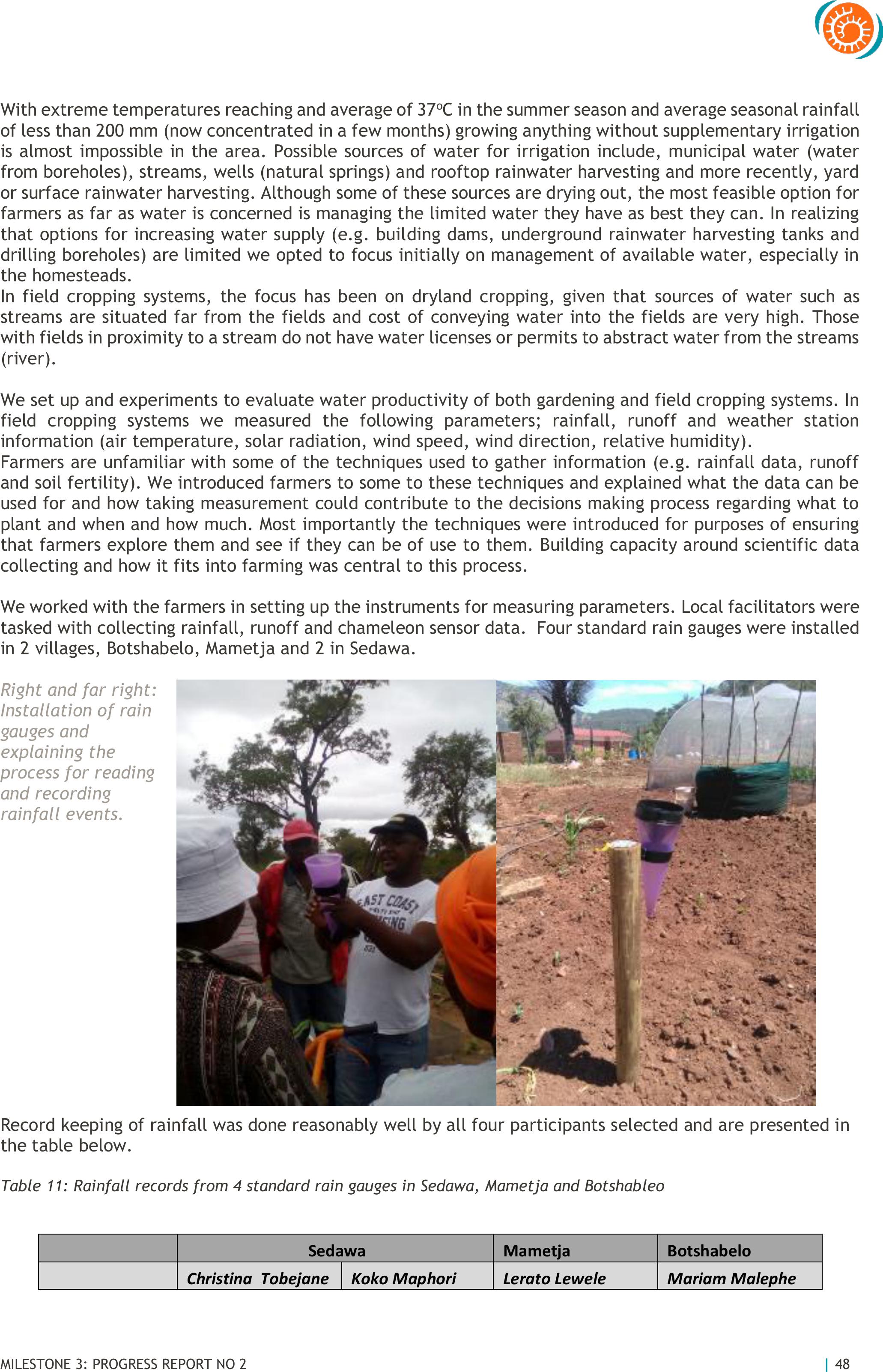
MILESTONE 3: PROGRESS REPORT NO 2
| 48
With extreme temperatures reaching and average of37oC in the summer season and average seasonal rainfall
of less than200 mm (now concentrated in a few months) growing anything without supplementaryirrigation
is almost impossible in the area. Possible sources of water for irrigation include, municipal water (water
from boreholes), streams, wells (natural springs) and rooftop rainwater harvesting and more recently, yard
or surface rainwater harvesting. Although some of these sources are drying out, the most feasible option for
farmers as far as water is concerned is managing the limited water they have as best they can. In realizing
that options for increasing water supply (e.g. building dams, underground rainwater harvesting tanks and
drilling boreholes) are limited we opted to focus initially on management of available water, especially in
the homesteads.
In field cropping systems, the focus has been ondrylandcropping, given that sources of water such as
streams are situated far from the fields and cost of conveying water into the fields are very high. Those
with fields in proximity toastream do not have water licenses or permits to abstract water from thestreams
(river).
We set up and experiments to evaluate water productivity of both gardening and field cropping systems. In
field cropping systems we measured the following parameters; rainfall, runoff and weather station
information (air temperature, solar radiation, wind speed, wind direction, relative humidity).
Farmers are unfamiliar with some of the techniques usedto gather information (e.g. rainfall data, runoff
and soil fertility). We introduced farmers to some to these techniques and explained what the data can be
used for and how taking measurement could contribute to the decisions making processregarding what to
plant and when and how much. Most importantly the techniques were introduced for purposes of ensuring
that farmers explore them and see if they can be of useto them. Building capacity around scientific data
collecting and how it fits into farming was central to this process.
We workedwith the farmersin setting up the instruments for measuring parameters. Local facilitators were
tasked with collecting rainfall, runoff and chameleon sensor data. Four standard rain gauges were installed
in 2 villages, Botshabelo, Mametja and 2 in Sedawa.
Right and far right:
Installation of rain
gauges and
explaining the
process for reading
and recording
rainfall events.
Record keeping of rainfall was done reasonably well by all four participants selected and are presented in
the table below.
Table 11: Rainfall records from 4 standard rain gauges in Sedawa, Mametja and Botshableo
Sedawa
Mametja
Botshabelo
Christina Tobejane
Koko Maphori
Lerato Lewele
Mariam Malephe
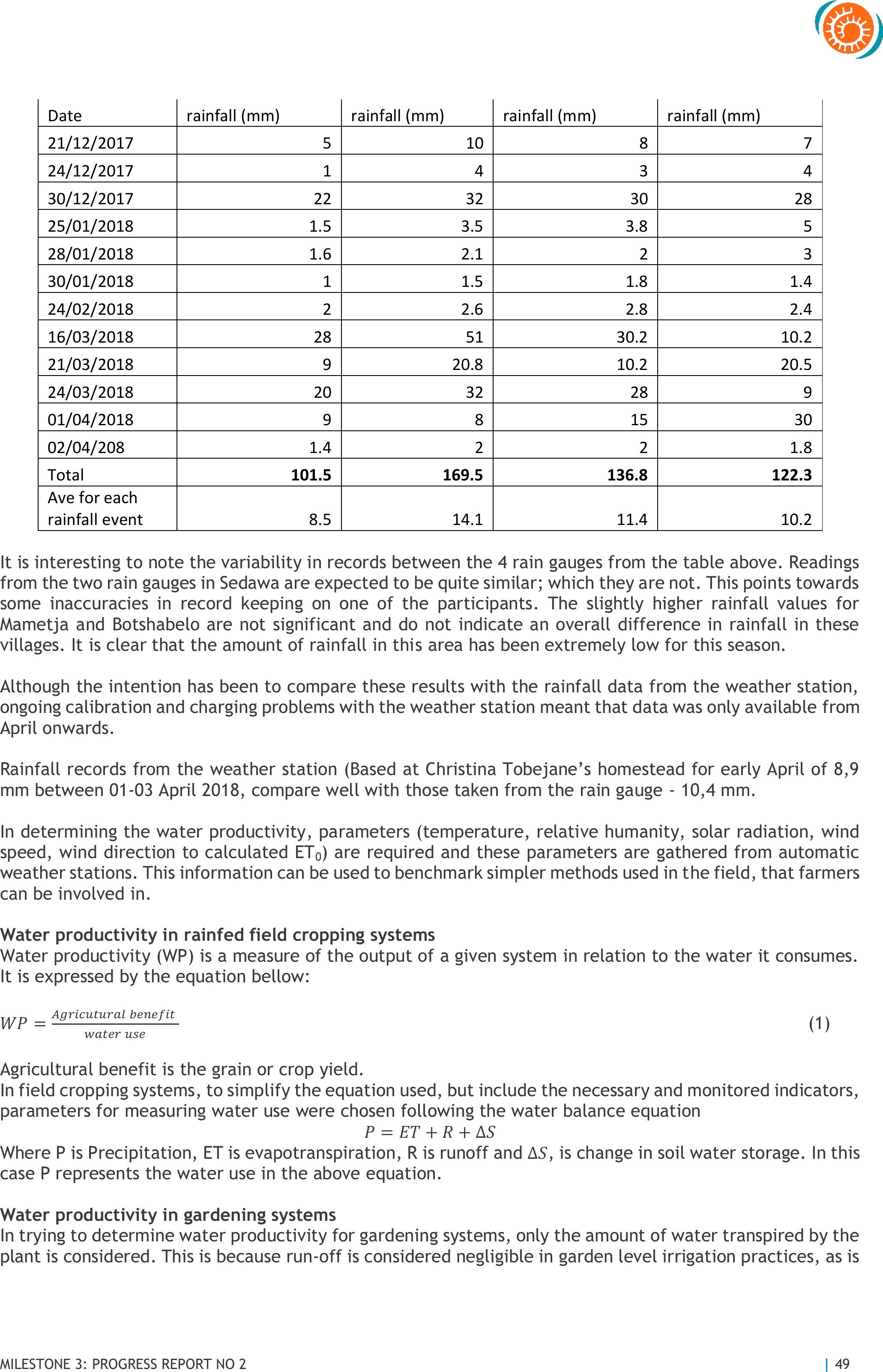
MILESTONE 3: PROGRESS REPORT NO 2
| 49
Date
rainfall (mm)
rainfall (mm)
rainfall (mm)
rainfall (mm)
21/12/2017
5
10
8
7
24/12/2017
1
4
3
4
30/12/2017
22
32
30
28
25/01/2018
1.5
3.5
3.8
5
28/01/2018
1.6
2.1
2
3
30/01/2018
1
1.5
1.8
1.4
24/02/2018
2
2.6
2.8
2.4
16/03/2018
28
51
30.2
10.2
21/03/2018
9
20.8
10.2
20.5
24/03/2018
20
32
28
9
01/04/2018
9
8
15
30
02/04/208
1.4
2
2
1.8
Total
101.5
169.5
136.8
122.3
Ave for each
rainfall event
8.5
14.1
11.4
10.2
It is interesting to note the variability in records between the 4 rain gauges from the table above. Readings
from the tworain gauges in Sedawa are expected to be quite similar; which they are not. This points towards
some inaccuracies in record keeping on one of the participants. The slightly higher rainfall values for
Mametja and Botshabelo are not significant and do not indicate an overall difference in rainfall in these
villages. It is clear that the amount of rainfall in this area has been extremely low for this season.
Although the intention has been to compare these results with the rainfall data from the weather station,
ongoing calibration and charging problemswith the weather station meant that data was only available from
April onwards.
Rainfall records from the weather station (Based at Christina Tobejane’s homestead for early April of 8,9
mm between 01-03 April 2018, compare well with those taken from the rain gauge - 10,4 mm.
In determining the water productivity, parameters (temperature, relative humanity, solar radiation, wind
speed, wind direction to calculated ET0) are required and these parameters are gathered from automatic
weather stations. This information can beusedto benchmark simpler methods used inthe field, that farmers
can be involved in.
Water productivity in rainfed field cropping systems
Water productivity (WP) is a measure of the output of a given system in relation to the water it consumes.
It is expressed by the equation bellow:
(1)
Agricultural benefit is the grain or crop yield.
In field cropping systems, to simplify the equation used, butinclude the necessary and monitored indicators,
parameters for measuring water use were chosen following the water balance equation
Where P is Precipitation, ET is evapotranspiration, R is runoff and, ischange in soil water storage. In this
case P represents the water use in the above equation.
Water productivity in gardening systems
In trying todetermine water productivity for gardening systems, only the amount of water transpired by the
plant is considered. This is because run-off is considered negligible in garden level irrigation practices, as is
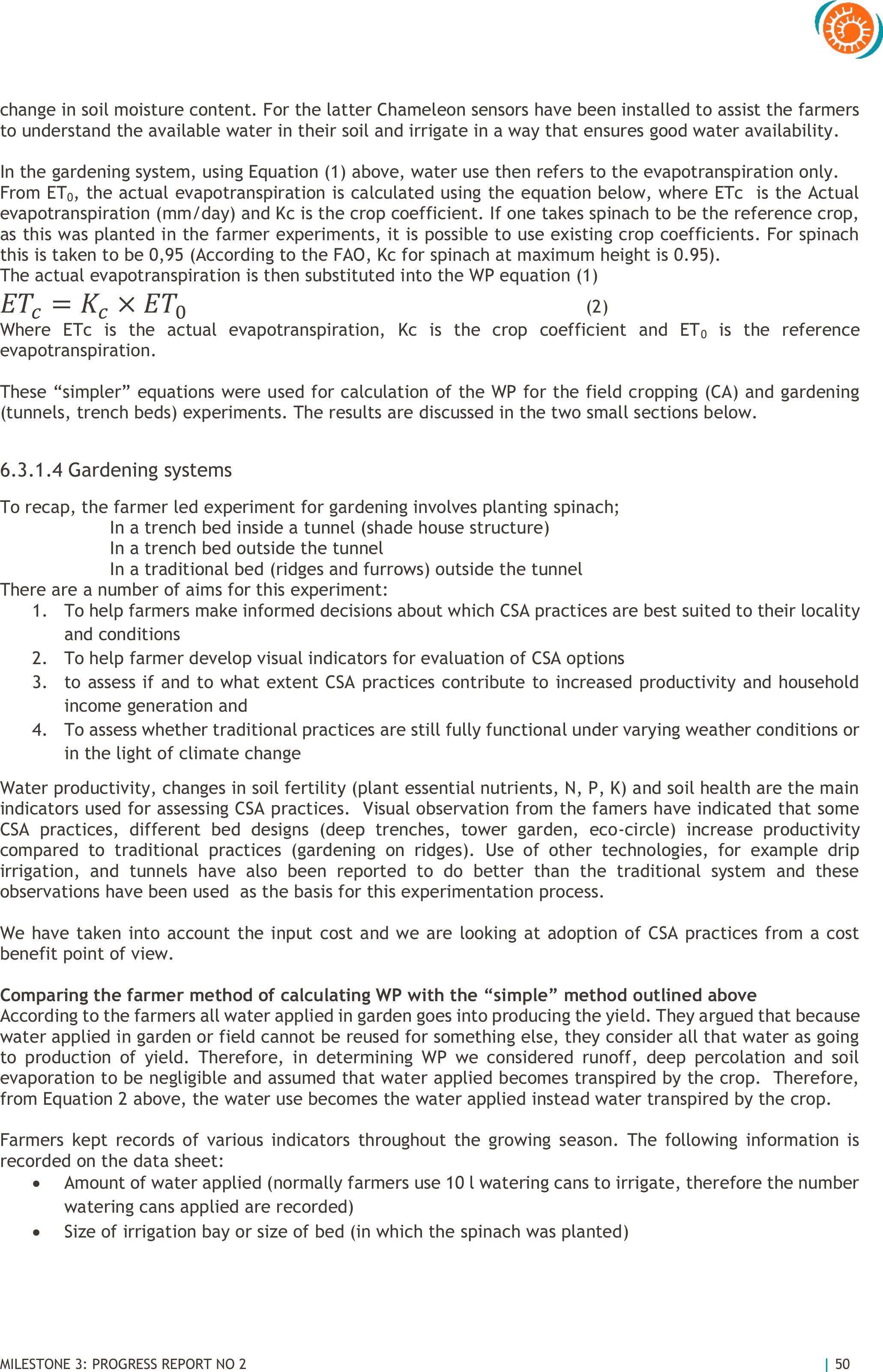
MILESTONE 3: PROGRESS REPORT NO 2
| 50
change in soil moisture content. For the latter Chameleon sensors have been installed to assist the farmers
to understand the available water in their soil and irrigate in a way that ensures good water availability.
In the gardening system, using Equation (1) above, water use then refers to the evapotranspiration only.
From ET0, the actual evapotranspiration is calculated using the equation below, where ETc isthe Actual
evapotranspiration (mm/day) and Kc is the crop coefficient. If one takes spinach to be the reference crop,
as thiswas planted in the farmer experiments, it is possible to use existing crop coefficients. For spinach
this is taken to be 0,95 (According to the FAO, Kc for spinach at maximum height is 0.95).
The actual evapotranspiration is then substituted into the WP equation (1)
(2)
Where ETc isthe actual evapotranspiration, Kc is the crop coefficient and ET0is the reference
evapotranspiration.
These “simpler” equationswere used for calculation of the WP for the field cropping (CA) and gardening
(tunnels, trench beds) experiments. The results are discussed in the two small sections below.
6.3.1.4Gardening systems
To recap, the farmer led experiment for gardening involves planting spinach;
In a trench bed inside a tunnel (shade house structure)
In a trench bed outside the tunnel
In a traditional bed (ridges and furrows) outside the tunnel
There are a number of aims for this experiment:
1.To help farmers make informed decisions about which CSA practices are best suited to their locality
and conditions
2.To help farmer develop visual indicators for evaluation of CSA options
3.to assess if and to what extent CSA practices contribute to increased productivity and household
income generation and
4.To assess whether traditional practices are still fully functional under varying weather conditions or
in the light of climate change
Water productivity, changes in soil fertility (plant essential nutrients, N, P, K) and soil health are the main
indicators used for assessing CSA practices. Visual observation from the famers have indicated that some
CSA practices, different bed designs (deep trenches, tower garden, eco-circle) increase productivity
compared to traditional practices (gardening on ridges). Use of other technologies, for example drip
irrigation, and tunnels have also been reported to do better than the traditional system and these
observations have been used as the basis for this experimentation process.
We have taken into account the inputcost and we are looking at adoption of CSA practices from a cost
benefit point of view.
Comparing the farmer method of calculating WP with the “simple” method outlined above
According to the farmers all water applied in garden goes into producing the yield. They argued that because
water applied in garden or field cannot be reused for something else, they consider all that water as going
to production of yield. Therefore, in determining WP we considered runoff, deep percolation and soil
evaporation to be negligible and assumed that water applied becomestranspired by the crop. Therefore,
from Equation 2 above, the water use becomes the water applied instead water transpired by the crop.
Farmers kept records of various indicators throughout the growing season. The following information is
recorded on the data sheet:
•Amount of water applied (normally farmers use 10 l watering cans toirrigate, therefore the number
watering cans applied are recorded)
•Size of irrigation bay or size of bed (in which the spinach was planted)
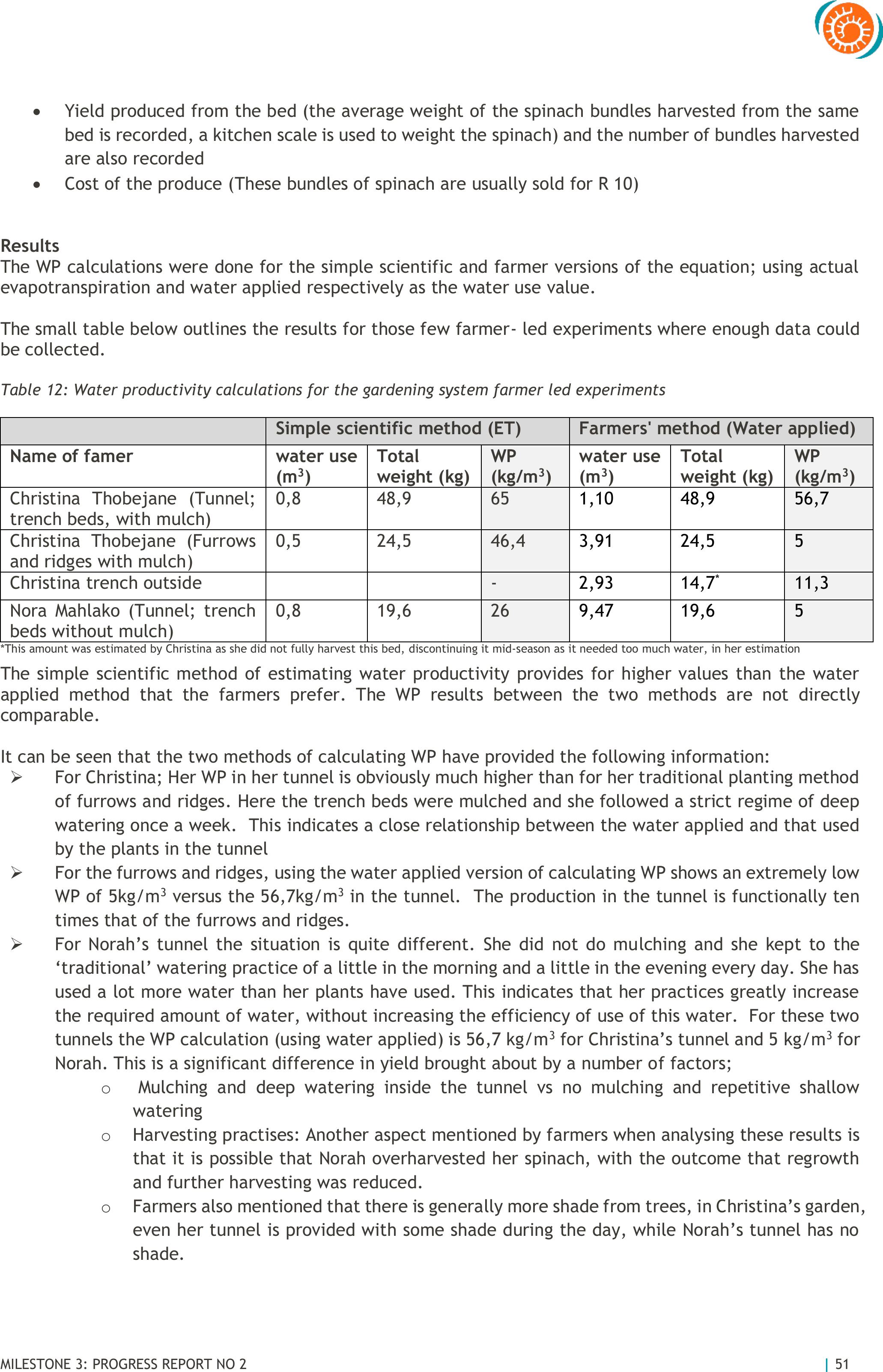
MILESTONE 3: PROGRESS REPORT NO 2
| 51
•Yield produced from the bed (the average weight of the spinach bundles harvested from the same
bed is recorded, akitchen scale is used to weight the spinach) and the number ofbundles harvested
are also recorded
•Cost of the produce (These bundles of spinach are usually sold for R 10)
Results
The WP calculations were done for the simple scientific and farmer versions of the equation; using actual
evapotranspiration and water applied respectively as the water use value.
The small table below outlines the results for those few farmer- led experiments where enough data could
be collected.
Table 12: Water productivity calculations for the gardening system farmer led experiments
Simple scientific method (ET)
Farmers' method (Water applied)
Name of famer
water use
(m3)
Total
weight (kg)
WP
(kg/m3)
water use
(m3)
Total
weight (kg)
WP
(kg/m3)
Christina Thobejane (Tunnel;
trench beds, with mulch)
0,8
48,9
65
1,10
48,9
56,7
Christina Thobejane (Furrows
and ridges with mulch)
0,5
24,5
46,4
3,91
24,5
5
Christina trench outside
-
2,93
14,7*
11,3
Nora Mahlako (Tunnel; trench
beds without mulch)
0,8
19,6
26
9,47
19,6
5
*This amount was estimated by Christina as she did not fully harvest this bed, discontinuing it mid-season as it needed too much water, in her estimation
The simple scientific method of estimating water productivity provides for higher values than the water
applied method that the farmers prefer. The WP results between the twomethods are not directly
comparable.
It can be seen that the two methods of calculating WP have provided the following information:
➢ForChristina; Her WP in her tunnel is obviously much higher than for her traditional planting method
of furrows and ridges. Here the trench beds were mulched and she followed a strict regime of deep
watering once a week. This indicates a close relationship between the water applied and that used
by the plants in the tunnel
➢For the furrowsand ridges, using the water applied version of calculating WP shows an extremely low
WP of 5kg/m3versus the 56,7kg/m3in the tunnel. The production in the tunnel is functionally ten
times that of the furrows and ridges.
➢For Norah’s tunnel the situation is quite different. She didnotdo mulching and she kept to the
‘traditional’ wateringpractice of a little in the morning and a little in the evening every day. She has
used a lot more water than her plants have used. This indicates that her practices greatly increase
the required amount of water, without increasing the efficiency of use of this water. For these two
tunnels the WP calculation (using water applied) is 56,7 kg/m3for Christina’s tunnel and 5 kg/m3 for
Norah. This is a significant difference in yield brought about by a number of factors;
o Mulching and deep watering inside the tunnel vs no mulching and repetitive shallow
watering
oHarvesting practises: Another aspect mentioned by farmers when analysing these results is
that it is possible thatNorah overharvested her spinach, withthe outcome that regrowth
and further harvesting was reduced.
oFarmers also mentioned that there is generally more shade from trees, in Christina’s garden,
even her tunnel is provided withsome shade during the day, while Norah’s tunnel hasno
shade.
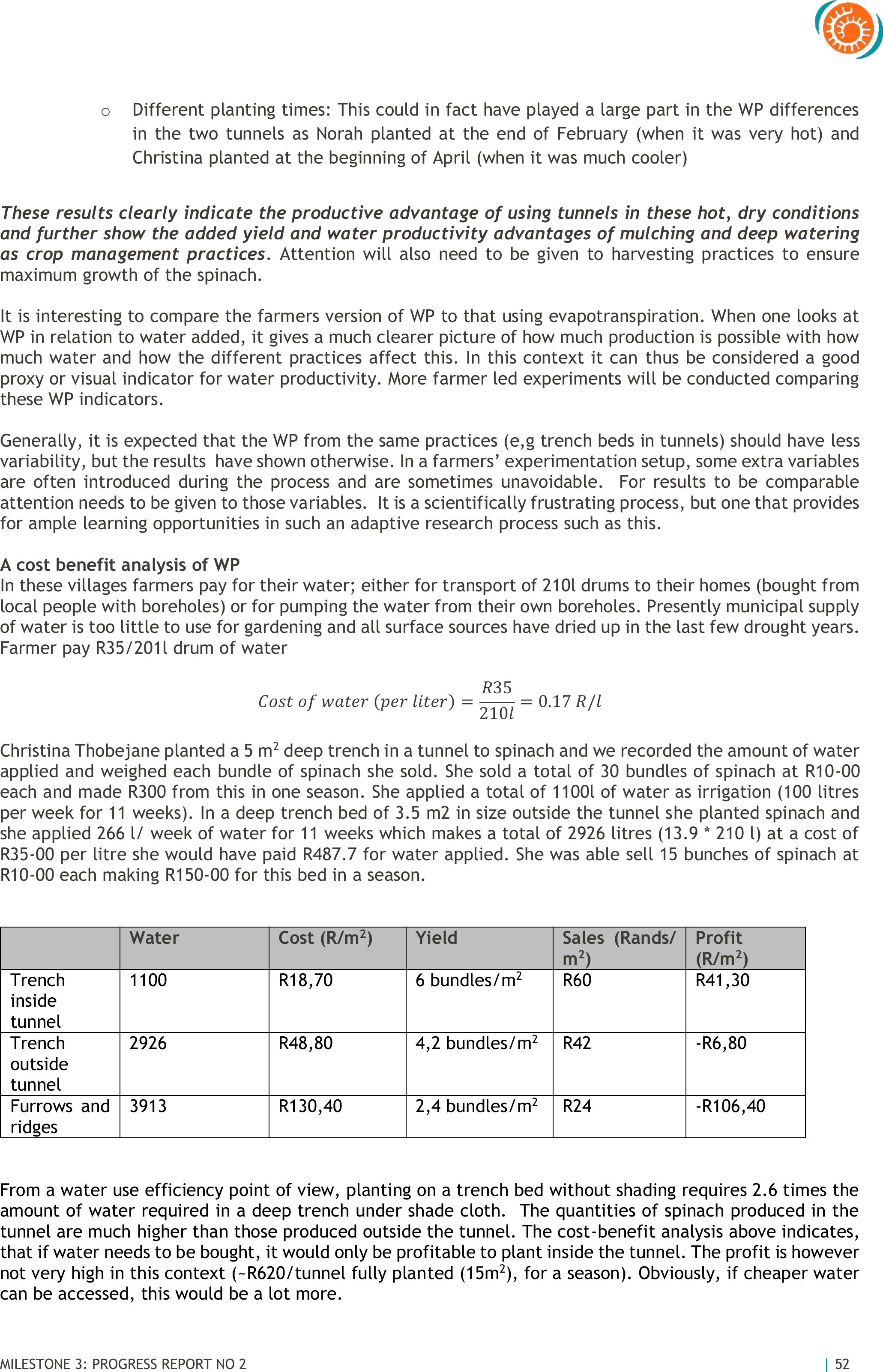
MILESTONE 3: PROGRESS REPORT NO 2
| 52
oDifferent planting times: This could in fact have played a large part in the WP differences
in the two tunnels as Norah planted at the end of February (when it was very hot) and
Christina planted at the beginning of April (when it was much cooler)
These results clearly indicate the productive advantage of using tunnels in these hot, dry conditions
and further show the added yield and water productivity advantages of mulching and deep watering
as crop management practices. Attention will alsoneed tobe given to harvesting practices to ensure
maximum growth of the spinach.
It is interesting to compare the farmers version of WP to that using evapotranspiration. When one looks at
WP in relation to water added, it gives a much clearer picture of how much production is possible with how
much water and how the different practices affect this. In this context it can thus be considered a good
proxy or visual indicator for water productivity. More farmer led experiments will be conducted comparing
these WP indicators.
Generally, it is expected that the WP from the same practices (e,g trench beds in tunnels) should have less
variability, but the results have shown otherwise. In afarmers’ experimentation setup, some extra variables
are often introduced during the processand are sometimes unavoidable. For results to be comparable
attention needstobe given to those variables. It isa scientifically frustrating process, but one that provides
for ample learning opportunities in such an adaptive research process such as this.
A cost benefit analysis of WP
In these villages farmers pay for their water; either for transport of 210l drums to their homes (bought from
local people with boreholes) or for pumping the water from their own boreholes. Presently municipal supply
of water is too little to use for gardening and all surface sources have dried up in the last few drought years.
Farmer pay R35/201l drum of water
Christina Thobejane planted a 5m2deep trench in a tunnel tospinach and werecorded the amount of water
applied and weighed each bundle of spinach she sold. Shesold a total of 30 bundles of spinach at R10-00
each and made R300 fromthis in one season. She applied a total of 1100l of water as irrigation (100 litres
per week for 11 weeks). In a deep trench bed of 3.5 m2 in size outside the tunnel she planted spinach and
she applied 266 l/ week of water for 11 weeks which makes a total of 2926 litres (13.9 * 210 l) at a cost of
R35-00 per litre she would have paid R487.7 for water applied. She was able sell 15 bunches of spinach at
R10-00 each making R150-00 for this bed in a season.
Water
Cost (R/m2)
Yield
Sales (Rands/
m2)
Profit
(R/m2)
Trench
inside
tunnel
1100
R18,70
6 bundles/m2
R60
R41,30
Trench
outside
tunnel
2926
R48,80
4,2 bundles/m2
R42
-R6,80
Furrows and
ridges
3913
R130,40
2,4 bundles/m2
R24
-R106,40
From a water use efficiency point of view, planting on a trench bed without shading requires 2.6 times the
amount ofwater required in a deep trench under shade cloth. The quantities of spinach produced in the
tunnel are much higher than those produced outside the tunnel. The cost-benefit analysis above indicates,
that if water needs tobe bought, it would only be profitable toplant inside the tunnel. The profit is however
not very high in this context (~R620/tunnel fully planted (15m2), for a season). Obviously, if cheaper water
can be accessed, this would be a lot more.
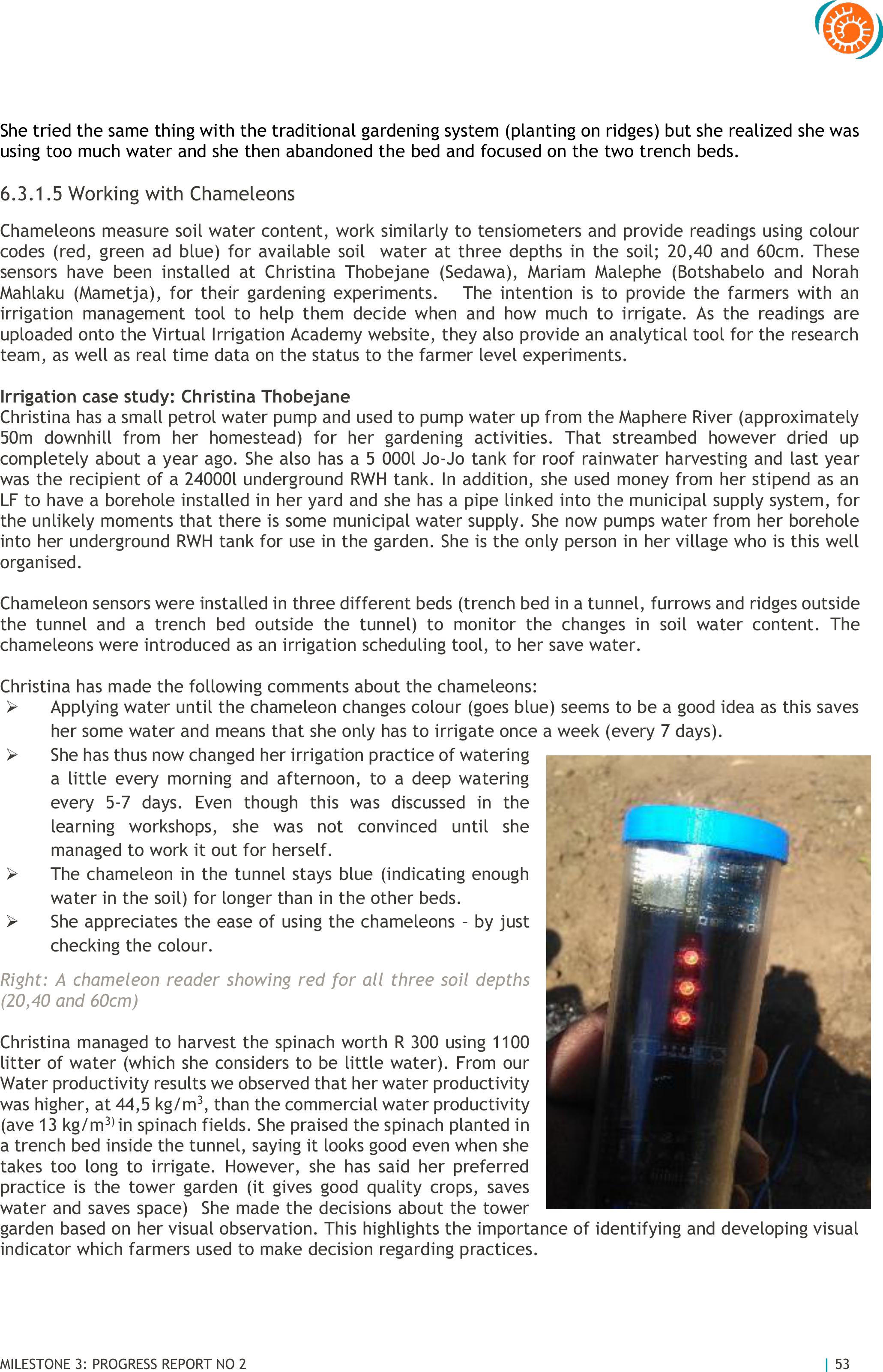
MILESTONE 3: PROGRESS REPORT NO 2
| 53
She tried the same thing with the traditional gardening system (planting on ridges) but she realized she was
using too much water and she then abandoned the bed and focused on the two trench beds.
6.3.1.5Working with Chameleons
Chameleons measure soil water content, work similarly to tensiometers and provide readings using colour
codes (red, green ad blue) for available soil water at three depths inthe soil; 20,40 and 60cm. These
sensors have been installed at Christina Thobejane (Sedawa), Mariam Malephe (Botshabelo and Norah
Mahlaku (Mametja), for their gardening experiments. The intention is to provide the farmers with an
irrigation management tool to help themdecidewhen and how much to irrigate. As the readings are
uploaded onto the Virtual Irrigation Academy website, they also provide an analytical tool for the research
team, as well as real time data on the status to the farmer level experiments.
Irrigation case study: Christina Thobejane
Christina has a small petrol water pump and used to pump water up from the Maphere River (approximately
50m downhill from her homestead) for her gardening activities. That streambed however dried up
completely about a year ago. She also has a 5000l Jo-Jo tank for roof rainwater harvesting and last year
was the recipient of a 24000l underground RWH tank. In addition, she used money from her stipend as an
LF to have a borehole installed in her yard and she has a pipe linked into the municipal supply system, for
the unlikely moments that there is some municipal water supply. She now pumps water from her borehole
into her underground RWH tank for use in the garden. She is the only person in her village who is this well
organised.
Chameleon sensors were installed in three differentbeds (trench bedin a tunnel,furrows and ridges outside
the tunnel and a trench bed outside the tunnel) to monitor the changes in soil watercontent. The
chameleons were introduced as an irrigation scheduling tool, to her save water.
Christina has made the following comments about the chameleons:
➢Applying water until the chameleon changes colour (goes blue) seems to be a good idea as this saves
her some water and means that she only has to irrigate once a week (every 7 days).
➢She has thus now changed her irrigation practice of watering
a little every morning andafternoon, to a deep watering
every 5-7 days. Even though this was discussed in the
learning workshops, she wasnot convinced until she
managed to work it out for herself.
➢The chameleon in the tunnel stays blue (indicating enough
water in the soil) for longer than in the other beds.
➢She appreciates the ease of using the chameleons – by just
checking the colour.
Right: A chameleon reader showing red for all three soil depths
(20,40 and 60cm)
Christina managed to harvest the spinach worth R 300 using 1100
litter ofwater (which she considers to be little water). From our
Water productivity results we observed thather waterproductivity
was higher, at 44,5 kg/m3, than the commercial water productivity
(ave 13kg/m3) in spinach fields. She praised the spinach planted in
a trench bed inside the tunnel, saying it looks good even when she
takes too long toirrigate.However, she hassaid her preferred
practice is the tower garden (it gives good quality crops, saves
water and saves space) She made the decisions about the tower
garden based on her visual observation. This highlights the importance of identifying and developing visual
indicator which farmers used to make decision regarding practices.
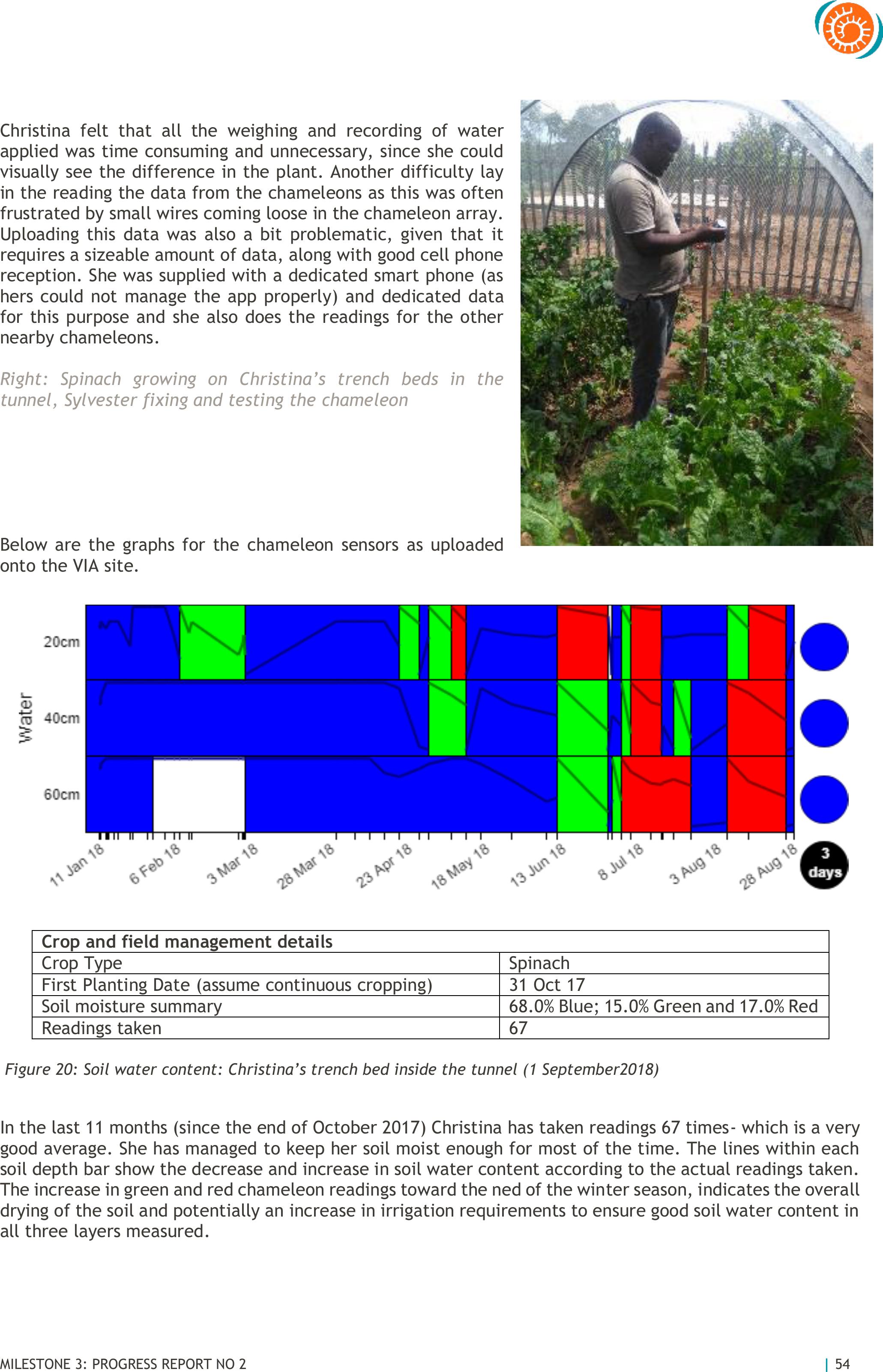
MILESTONE 3: PROGRESS REPORT NO 2
| 54
Christina felt that all the weighing and recording of water
applied was time consuming and unnecessary, since she could
visually see the difference in the plant. Another difficulty lay
in the reading the data from the chameleons as this was often
frustrated by small wires coming loose in the chameleon array.
Uploading this data was also a bitproblematic, given thatit
requires a sizeable amount of data, along with good cell phone
reception. She was supplied with adedicated smart phone (as
hers could not manage the app properly) and dedicated data
for this purpose and she also does the readings for the other
nearby chameleons.
Right: Spinach growing on Christina’s trench beds in the
tunnel, Sylvester fixing and testing the chameleon
Below are the graphs for the chameleon sensors as uploaded
onto the VIA site.
Figure 20: Soil water content: Christina’s trench bed inside the tunnel (1 September2018)
In the last 11 months (since the end of October 2017) Christina has taken readings 67 times- which is a very
good average. She has managed tokeep her soil moist enough for most ofthe time. The lines within each
soil depth bar show the decrease and increase in soil water content according to the actual readings taken.
The increase in green and red chameleon readings toward the ned of the winter season, indicates the overall
drying of the soil and potentially an increase in irrigation requirements to ensure good soil water content in
all three layers measured.
Crop and field management details
Crop Type
Spinach
First Planting Date (assume continuous cropping)
31 Oct 17
Soil moisture summary
68.0% Blue; 15.0% Green and 17.0% Red
Readings taken
67
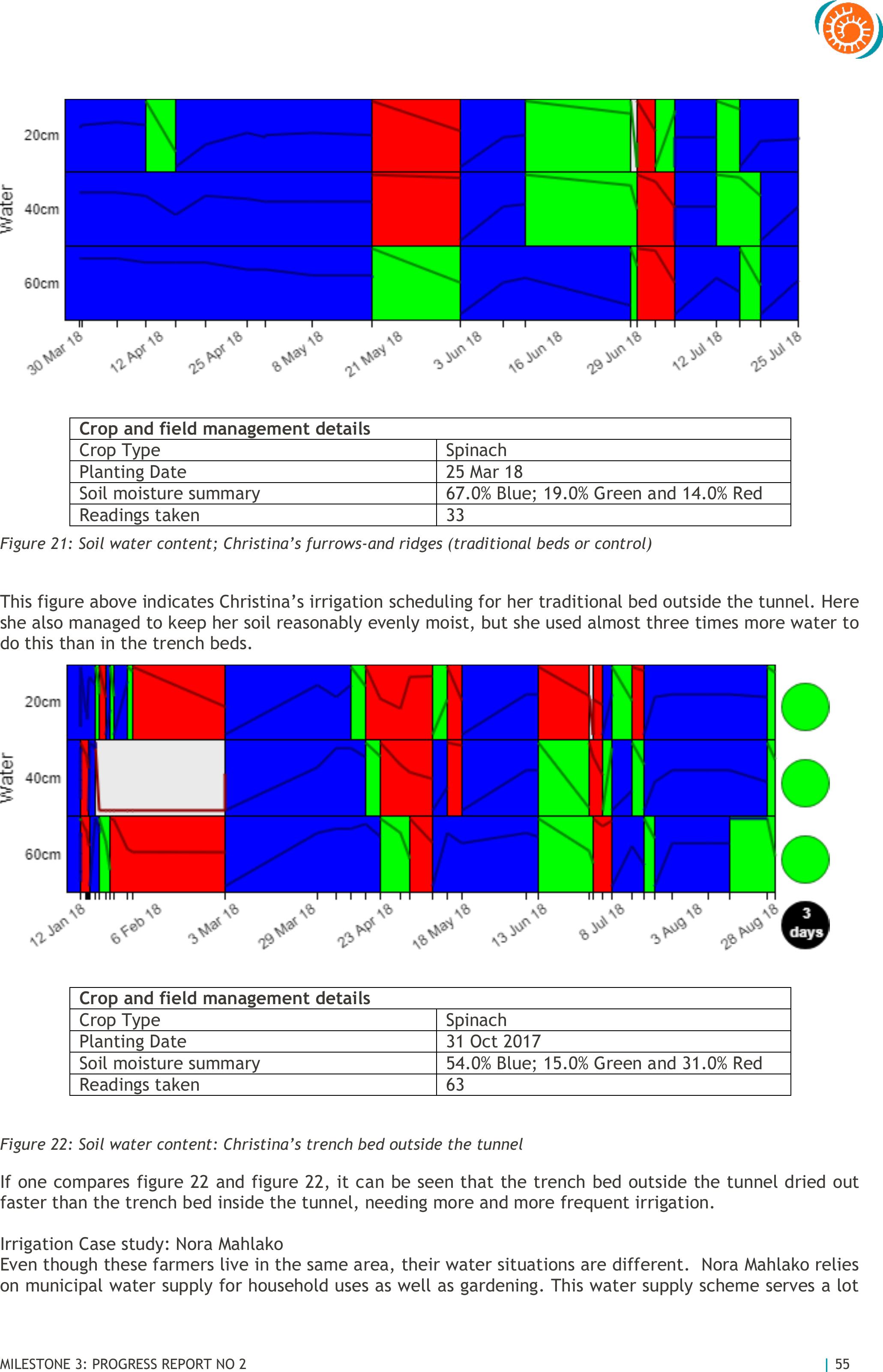
MILESTONE 3: PROGRESS REPORT NO 2
| 55
Figure 21: Soil water content; Christina’s furrows-and ridges (traditional beds or control)
This figure above indicates Christina’s irrigation scheduling for her traditional bed outside the tunnel. Here
she also managed to keep her soil reasonably evenly moist, but she used almost three times more water to
do this than in the trench beds.
Figure 22: Soil water content: Christina’s trench bed outside the tunnel
If one compares figure 22 and figure 22, it can be seen that the trench bed outside the tunnel dried out
faster than the trench bed inside the tunnel, needing more and more frequent irrigation.
Irrigation Case study: Nora Mahlako
Even though these farmers live in the same area, their water situations are different. Nora Mahlako relies
on municipal water supply for household uses aswell as gardening. This water supply scheme serves a lot
Crop and field management details
Crop Type
Spinach
Planting Date
25 Mar 18
Soil moisture summary
67.0% Blue; 19.0% Green and 14.0% Red
Readings taken
33
Crop and field management details
Crop Type
Spinach
Planting Date
31 Oct 2017
Soil moisture summary
54.0% Blue; 15.0% Green and 31.0% Red
Readings taken
63
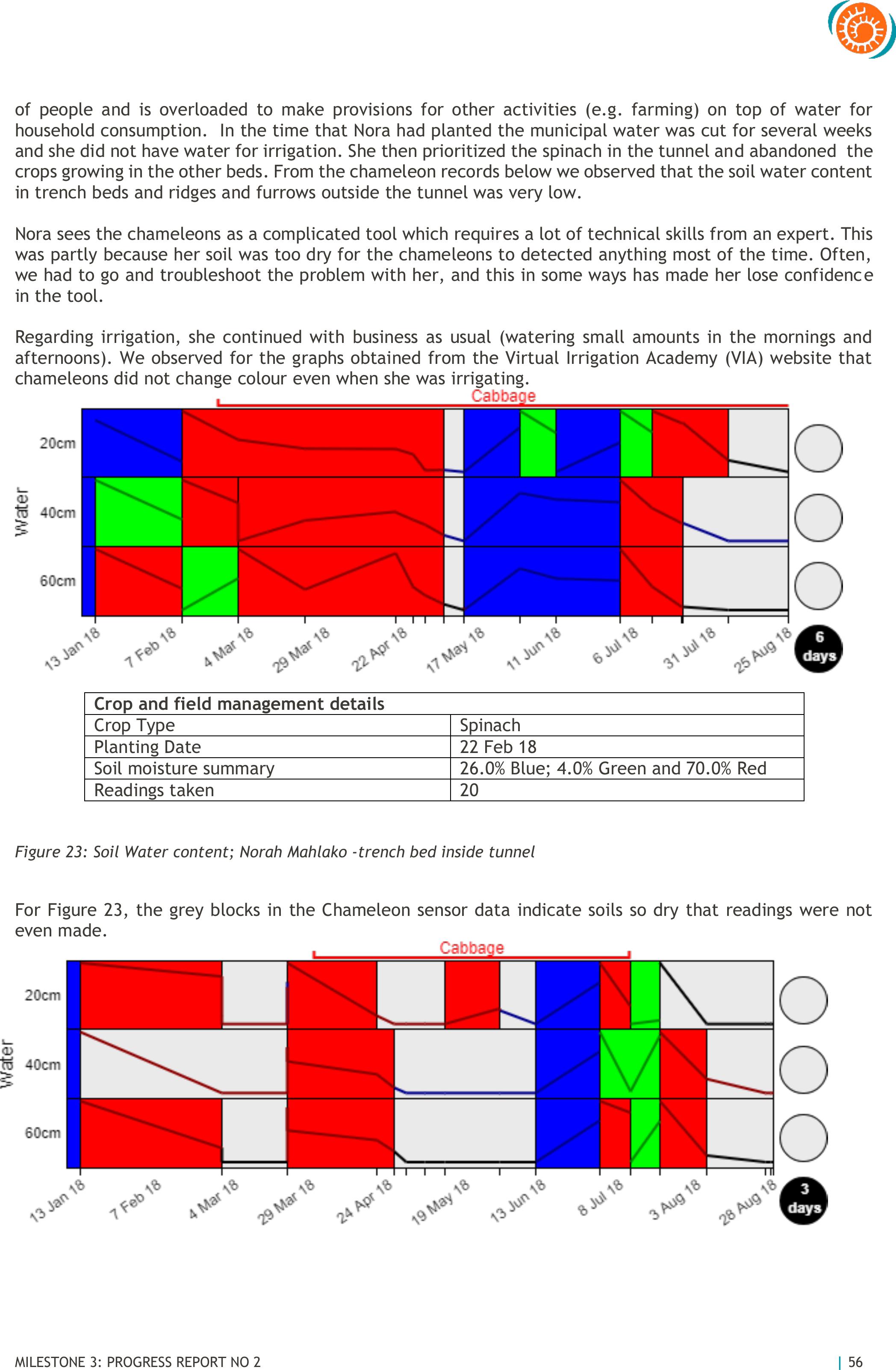
MILESTONE 3: PROGRESS REPORT NO 2
| 56
of people and isoverloaded tomake provisions for other activities (e.g. farming) on top of water for
household consumption. In the time that Nora had planted the municipal water was cut for several weeks
and she did not have water for irrigation. She then prioritized the spinach in the tunnel and abandoned the
crops growing in the other beds. From the chameleon records below we observed that the soil water content
in trench beds and ridges and furrows outside the tunnel was very low.
Nora sees the chameleons as a complicated tool which requires a lot of technical skills from an expert. This
was partly because her soil was too dry for the chameleons todetected anything most of the time. Often,
we had to go and troubleshoot the problem with her, and this in some ways has made her lose confidence
in the tool.
Regarding irrigation, she continued with businessas usual (watering small amounts in the mornings and
afternoons). We observed for the graphs obtained from the Virtual Irrigation Academy (VIA) website that
chameleons did not change colour even when she was irrigating.
Figure 23: Soil Water content; Norah Mahlako -trench bed inside tunnel
For Figure 23, the grey blocks in the Chameleon sensor data indicate soils sodry that readings were not
even made.
Crop and field management details
Crop Type
Spinach
Planting Date
22 Feb 18
Soil moisture summary
26.0% Blue; 4.0% Green and 70.0% Red
Readings taken
20
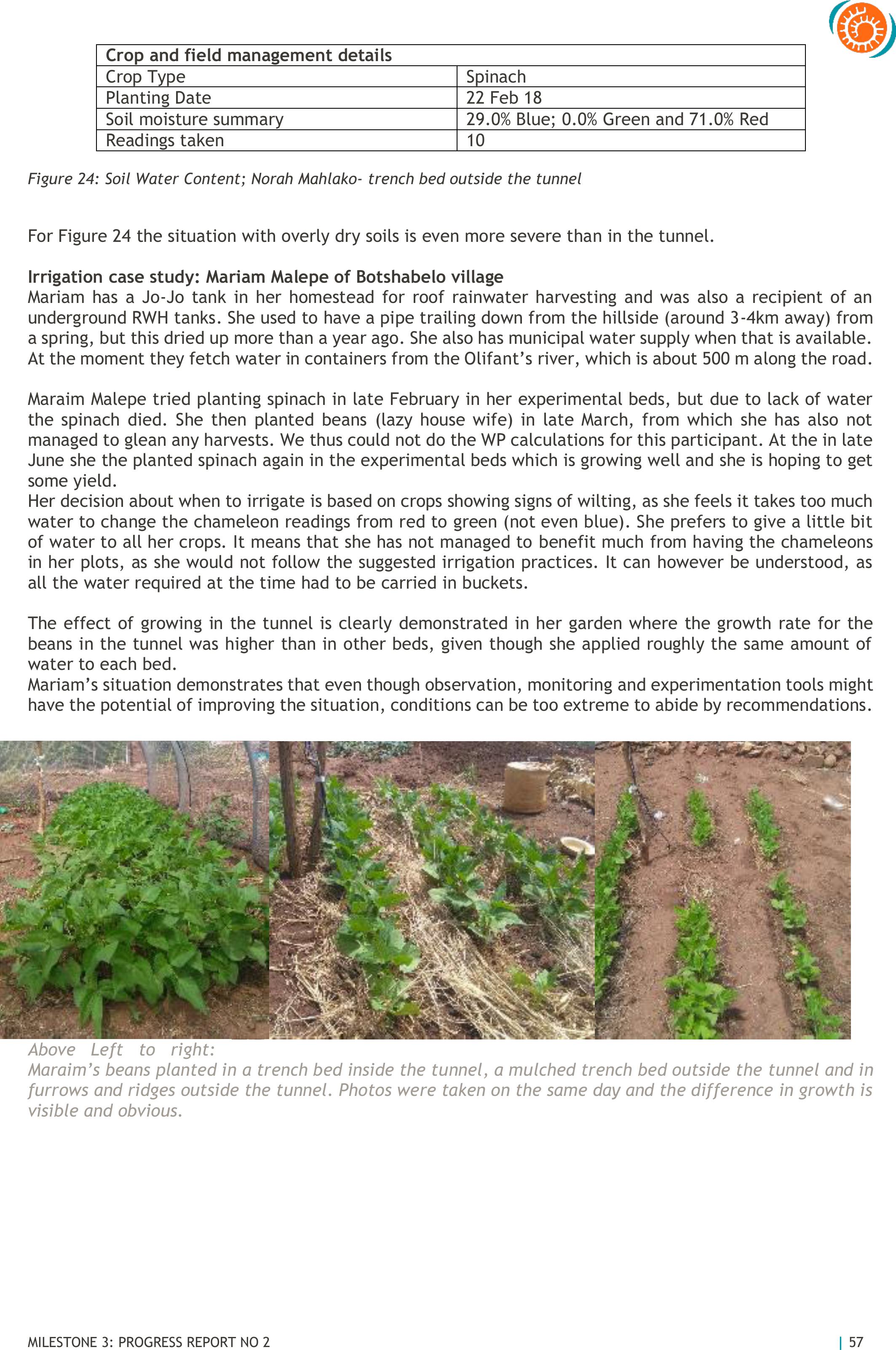
MILESTONE 3: PROGRESS REPORT NO 2
| 57
Figure 24: Soil Water Content; Norah Mahlako- trench bed outside the tunnel
For Figure 24 the situation with overly dry soils is even more severe than in the tunnel.
Irrigation case study: Mariam Malepe of Botshabelo village
Mariam hasa Jo-Jo tank in her homestead for roofrainwater harvesting and was also a recipientof an
underground RWH tanks. She used to have a pipe trailing down from the hillside (around 3-4km away) from
a spring, but this dried up more than ayear ago. She also has municipal water supply when that is available.
At the moment they fetch water incontainers from the Olifant’s river, which is about 500 m along the road.
Maraim Malepe tried planting spinach in late February in her experimental beds, but due tolack of water
the spinach died. She then planted beans(lazy house wife) in late March, from which she has also not
managed to glean any harvests. We thus could not do the WP calculations for this participant. At the in late
June she the planted spinach again in the experimental beds which is growing well and she is hoping to get
some yield.
Her decision about when to irrigate is based on crops showing signs of wilting, as she feels it takes too much
water to change the chameleon readings from red to green (not even blue). She prefers to give a little bit
of water to all her crops. It means that she has not managed to benefit much from having the chameleons
in herplots, as she would not follow the suggested irrigation practices. It can however be understood, as
all the water required at the time had to be carried in buckets.
The effect of growing in the tunnel is clearly demonstrated in her garden where the growth rate for the
beans in thetunnel was higher than in other beds, given though she applied roughly the same amountof
water to each bed.
Mariam’s situation demonstrates that even though observation, monitoringand experimentation tools might
have the potential of improving the situation, conditions can be too extreme to abide by recommendations.
Above Left to right:
Maraim’s beans planted in a trench bed inside the tunnel, a mulched trench bed outside the tunnel and in
furrows and ridges outside the tunnel. Photos were taken on the same day and the difference in growth is
visible and obvious.
Crop and field management details
Crop Type
Spinach
Planting Date
22 Feb 18
Soil moisture summary
29.0% Blue; 0.0% Green and 71.0% Red
Readings taken
10
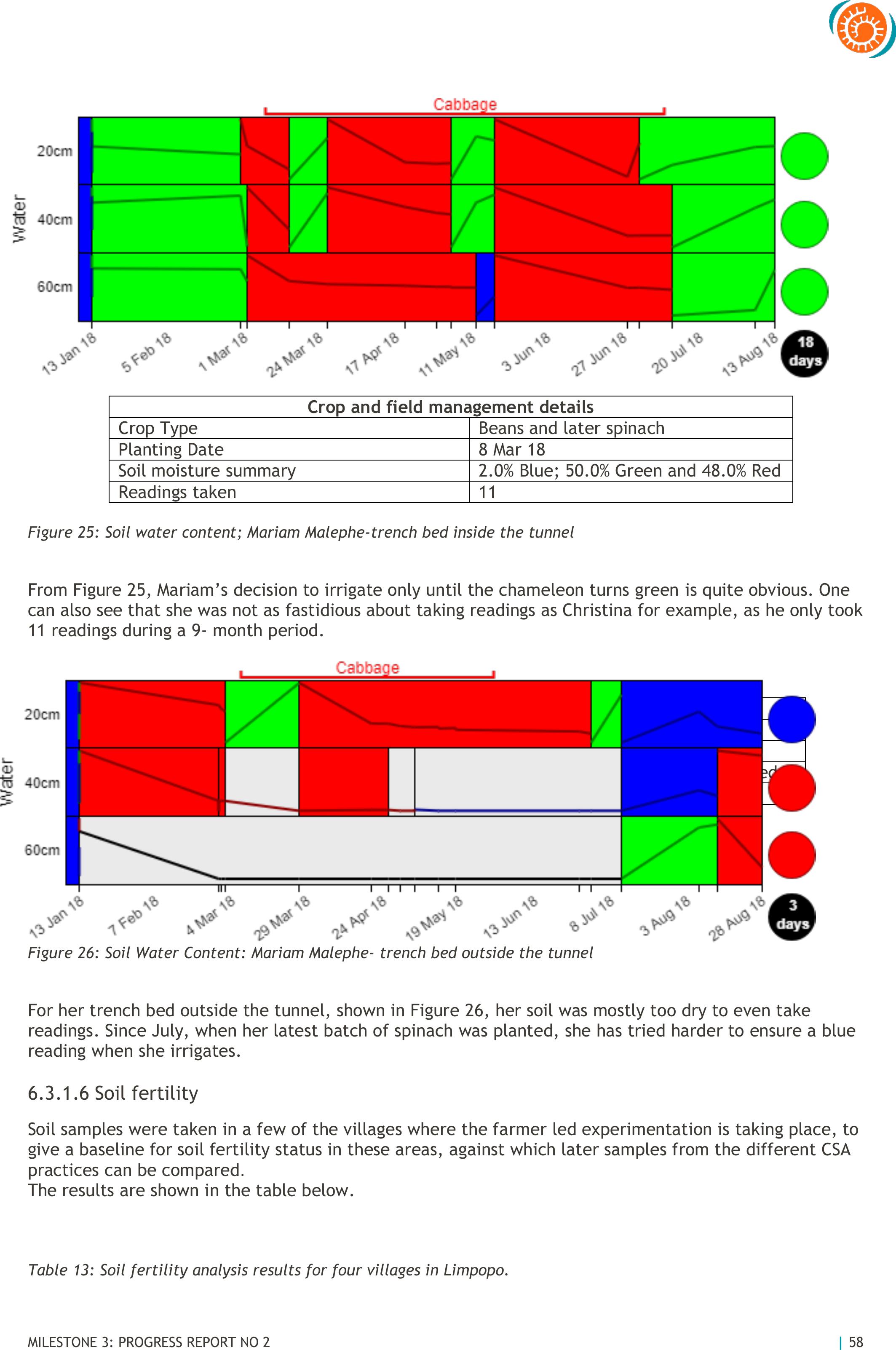
MILESTONE 3: PROGRESS REPORT NO 2
| 58
Figure 25: Soil water content; Mariam Malephe-trench bed inside the tunnel
From Figure 25, Mariam’s decision to irrigate only until the chameleon turns green is quite obvious. One
can also see that she was not as fastidious about taking readings as Christina for example, as he only took
11 readings during a 9- month period.
Figure 26: Soil Water Content: Mariam Malephe- trench bed outside the tunnel
For her trench bed outside the tunnel, shown in Figure 26, her soil was mostly too dry to even take
readings. Since July, when her latest batch of spinach was planted, she has tried harder to ensure a blue
reading when she irrigates.
6.3.1.6Soil fertility
Soil samples were taken in a few of the villages where the farmer led experimentation is taking place, to
give a baseline for soil fertility status in these areas, against which later samples from the different CSA
practices can be compared.
The results are shown in the table below.
Table 13: Soil fertility analysis results for four villages in Limpopo.
Crop and field management details
Crop Type
Beans and later spinach
Planting Date
8 Mar 18
Soil moisture summary
2.0% Blue; 50.0% Green and 48.0% Red
Readings taken
11
Crop and field management details
Crop Type
Beans and later spinach
Planting Date
8 Mar 18
Soil moisture summary
20.0% Blue; 16.0% Green and 64.0% Red
Readings taken
11
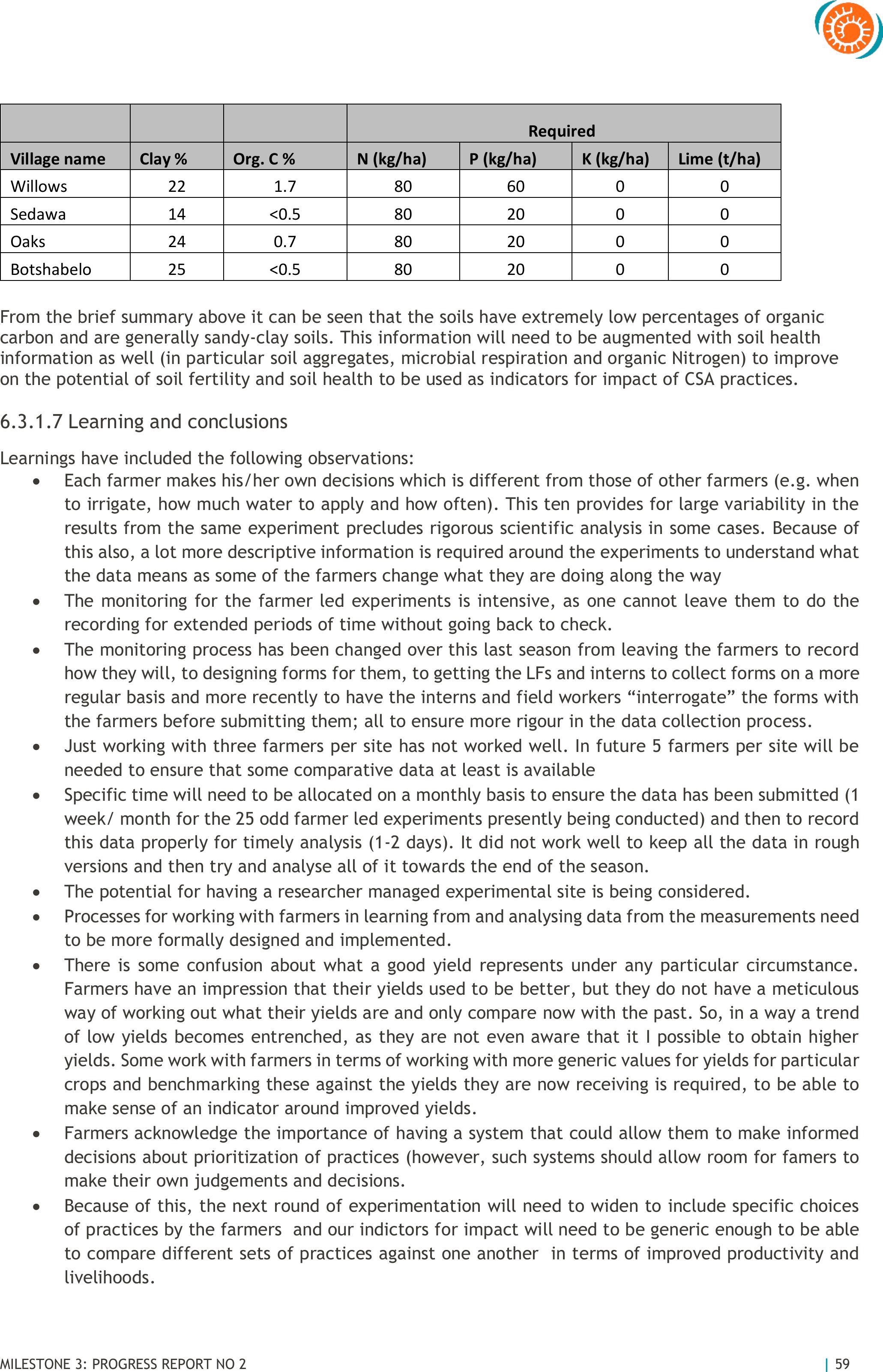
MILESTONE 3: PROGRESS REPORT NO 2
| 59
From the brief summary above it can be seen that the soils have extremely low percentages of organic
carbon and are generally sandy-clay soils. This information will need to be augmented with soil health
information as well (in particular soil aggregates, microbial respiration and organic Nitrogen) to improve
on the potential of soil fertility and soil health to be used as indicators for impact of CSA practices.
6.3.1.7Learning and conclusions
Learnings have included the following observations:
•Each farmer makes his/her own decisions which is different from those of other farmers (e.g. when
to irrigate, how much water toapply and how often). Thisten provides for large variability in the
results fromthe same experiment precludes rigorous scientific analysis in some cases. Becauseof
this also, alot more descriptive information is required around the experiments to understand what
the data means as some of the farmers change what they are doing along the way
•The monitoring for the farmer led experiments is intensive, as one cannot leave them to do the
recording for extended periods of time without going back to check.
•The monitoring process has been changed over this last season from leaving the farmers torecord
how they will, to designing forms for them, to getting the LFs and interns to collect forms on a more
regular basis and more recently to have the interns and field workers “interrogate” the forms with
the farmers before submitting them; all to ensure more rigour in the data collection process.
•Just working with three farmers per sitehas not worked well. In future 5 farmers per site will be
needed to ensure that some comparative data at least is available
•Specific time will need to be allocated on a monthly basis to ensure the data has been submitted (1
week/ month for the 25 odd farmer led experiments presently being conducted) and then to record
this data properly for timely analysis(1-2 days). Itdid not work well to keep all the data inrough
versions and then try and analyse all of it towards the end of the season.
•The potential for having a researcher managed experimental site is being considered.
•Processes for working with farmers in learning from and analysing datafrom the measurements need
to be more formally designed and implemented.
•There is some confusion about what a good yield represents under any particular circumstance.
Farmers have an impression that their yields used to be better, but they do not have a meticulous
way of working out what their yields are and only compare now with the past. So, in a way a trend
of low yields becomes entrenched, astheyare not even aware that it I possible to obtain higher
yields. Some work with farmers in terms of working with more generic values for yields for particular
crops and benchmarking these against the yields they are now receiving isrequired, to be able to
make sense of an indicator around improved yields.
•Farmers acknowledge the importance of having asystem that could allow them to make informed
decisions about prioritizationof practices (however, such systems should allow room for famers to
make their own judgements and decisions.
•Because of this,the next round of experimentation will need towiden toinclude specific choices
of practices by the farmers and our indictors for impact will need to be generic enough to be able
to compare different sets of practices against one another in terms of improved productivity and
livelihoods.
Required
Village name
Clay %
Org. C %
N (kg/ha)
P (kg/ha)
K (kg/ha)
Lime (t/ha)
Willows
22
1.7
80
60
0
0
Sedawa
14
<0.5
80
20
0
0
Oaks
24
0.7
80
20
0
0
Botshabelo
25
<0.5
80
20
0
0